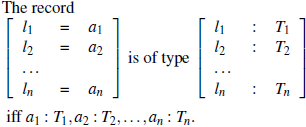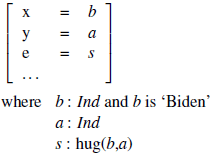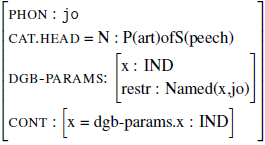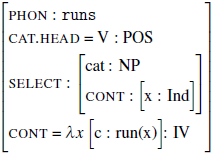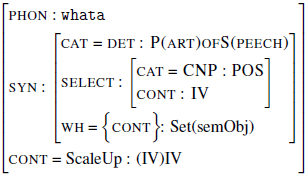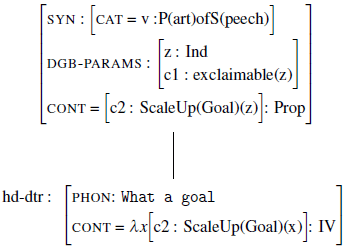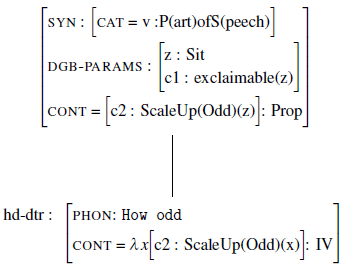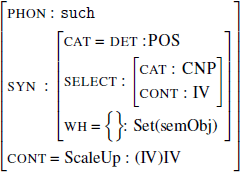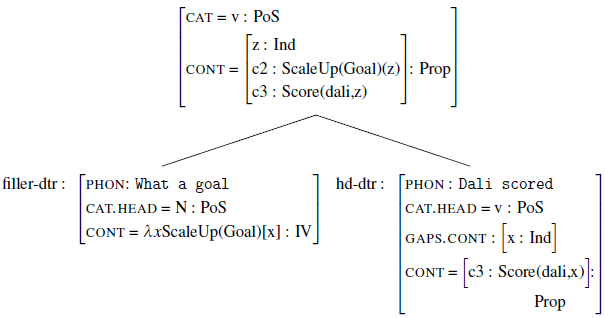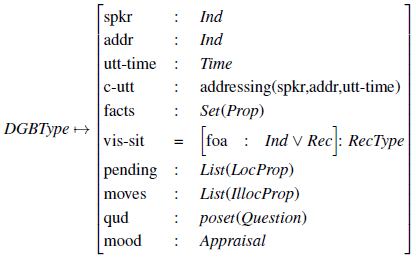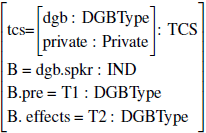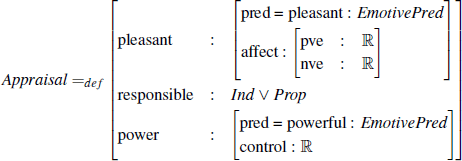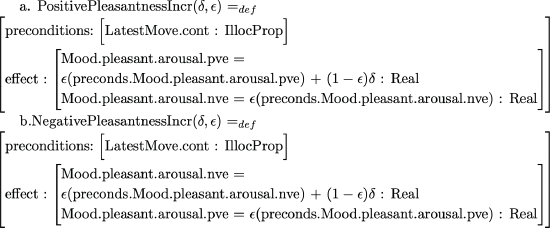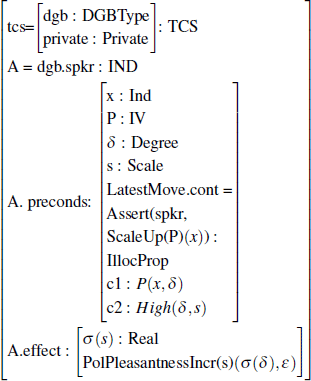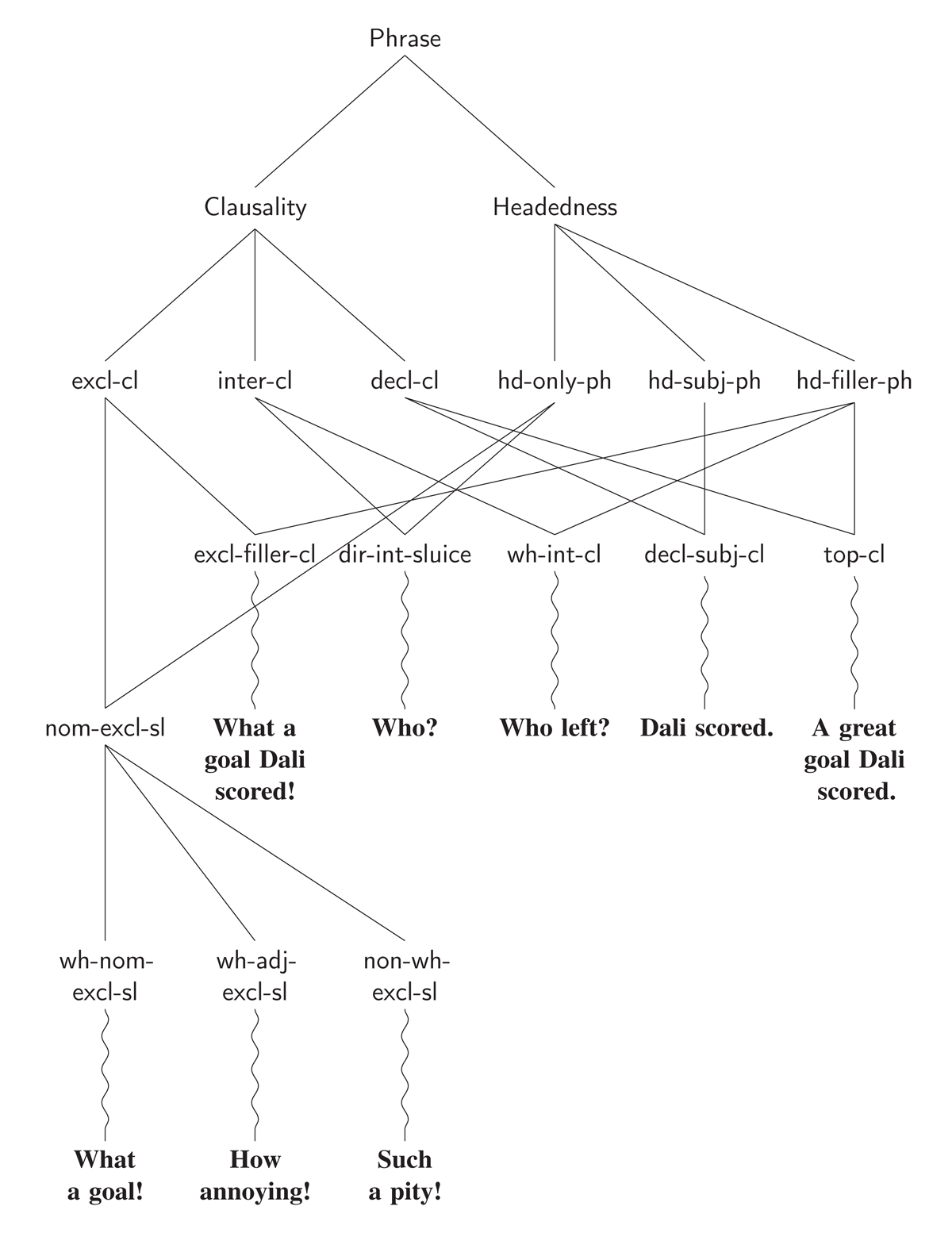1 Introduction
But what about this: is the call “Slab!” in example (2) a sentence or a word? — If a word, surely it has not the same meaning as the like-sounding word of our ordinary language, for in §2 it is a call. But if a sentence, it is surely not the elliptical sentence “Slab!” of our language. As far as the first question goes, you can call “Slab!” a word and also a sentence; perhaps it could aptly be called a ‘degenerate sentence’ (as one speaks of a degenerate hyperbola); in fact it is our “elliptical” sentence. But that is surely only a shortened form of the sentence “Bring me a slab”, and there is no such sentence in example (2). But why shouldn’t I conversely have called the sentence “Bring me a slab” a lengthening of the sentence “Slab!”? (Wittgenstein 1953: §19)
In a variety of languages bare wh-phrases can function as complete utterances, as exemplified in the bold-faced utterances in (1):
- (1)
- a.
- English
- (1a(i))
- A: I’m just bursting for a drink. c: all right, what sort of a drink? (London-Lund corpus, (Svartvik & Quirk 1980)
- (1a(ii))
- Mother: Show her what’s in the box. Sarah (Ch): Alright . Gail (In): ooh (pause) how beautiful! (From the Manchester corpus, (Rowland et al. 2003)
- b.
- French:
- (1b(i))
- L2: Je prends le métro le matin bon jusqu’au Palais Royal
- L2: I take the metro every morning to Palais Royal.
- L1: À quelle heure?
- L1: At what hour?
- (Rhapsodie corpus https://rhapsodie.modyco.fr/static/#M2006, extract from (Branca-Rosoff et al. 2000))
- (1b(ii))
- (Context: live blog of football game):
- Quelle frappe de Delphine Cascarino!
- What a shot by Delphine Cascarino!
- (10 July, 2022, Le Monde)
- c.
- Hebrew:
- (1c(i))
- Barnur: ze iš asaqim prati! šney anšey asaqim.
- Barnur: It’s a private (sector) businessman! Two businessmen.
- Netanyahu: eyze iš asqim prati?
- Netanyahu: What private (sector) businessman?
- (Haaretz, https://www.haaretz.co.il/news/law/1.7482553)
- (1c(ii))
- še yehiye lax behaclaxa! eyze teuza!
- All the best to you! What daring!
- (Haaretz, comment section, July 10, 2022)
One use such phrases have is interrogative (examples (1)a(i),b(i),c(i)) and has been known since (Ross 1969) as sluicing. Since that time interrogative sluicing has been at the centre of an as yet unresolved debate concerning elliptical constructions. Do such constructions involve deletion from underlyingly sentential structures (‘move and delete’) (Ross 1969; Merchant 2001; Van Craenenbroeck & Lipták 2006; Vicente 2018) or should they be analyzed as sui generis constructions (Dialogue–oriented Constructionism/Direct Interpretation) where there is no covert syntactic structure and where composition is contextually driven (Ginzburg & Sag 2000; Culicover & Jackendoff 2005; Jacobson 2016).1,2 Missing from that debate is an exclamative use that a subset of sluiced wh-phrases can exhibit (henceforth exclamative sluices), as exemplified in (1)a(ii),b(ii),c(ii)).3
Our claim will be that, as far as exclamative sluices go, there is overwhelming evidence in favour of a dialogically oriented, direct interpretation approach and against viewing exclamative sluices as covert, sentential exclamative clauses. Perhaps the most obvious datum in this respect is the fact that, as pointed out in Ginzburg 2012: p. 227 exclamative sluices, in contrast to exclamative clauses do not embed, as exemplified in (2):
- (2)
- a.
- Captain Robert Churchwood M.C., who was a master of hau master of hounds for thirty years or so has now changed his views having realized how utterly filthy, degrading and barbarous the whole thing is. (London-Lund Corpus)
- b.
- … over sherry before dinner the president was drivelling on about what an absolutely splendid reputation St Mark’s was building up for music scholarship (London-Lund Corpus)
- c.
- (Context: Evert runs and hooks a two hander at the last second crosscourt. Mandlikova thinking it was going down the line.): (#It’s amazing) what a clever stroke (!).4
- d.
- (Context: Jo has just set a new world record.) (#Chris told me) what a great runner (!)
- e.
- A: Bo has suggested the earth goes around the moon. B: (# We are aware) how silly (!)
In addition to this, in section 2.1 we provide corpus evidence for the direct interpretation approach: we provide evidence that exophoric uses of exclamative sluices, uses where the resolution is not transparently based on a linguistic antecedent, are in fact majoritarian across several corpora; indeed, as we discuss in that section, building on earlier work by Siemund (2017), exclamative sluices are significantly commoner than exclamative clauses. In section 2.2, we also point to additional semantic differences between exclamative sluices and exclamative clauses.
At the same time there are important similarities between the two in that, for instance, (3a,b) in a particular context may express the same content.
- (3)
- a.
- What a goal!
- b.
- What a goal that was!
This means that whatever denotation type one posits for the one needs to apply to the other. Hence, the need to develop a unified analysis that also captures their differences. There are important insights in recent work on exclamative clauses on which we will draw in section 3, where we develop our formal account of exclamative sluices and clauses. In particular, (i) exclamatives often express high scalar degree (Michaelis & Lambrecht 1996; Rett 2011) (ii) wh–exclamative clauses constitute an unbounded dependency construction (Sag 2010).
While (ii) might appear to be obvious, exclamative sluices introduce a new twist into the picture. One requires an account of the grammar of wh-exclamative phrases that disallows in situ occurrences of exclamatives, as in (4a). But at the same time, if there is no deleted/covert clause in exclamative sluice uses such as (4b), one cannot postulate dislocation for such cases:
- (4)
- a.
- *Bo saw what a statue!
- b.
- (Context: Spurs counter once more as a cross is cleared up to Son on the halfway. The South Korean bides his time as he dribbles towards the box, before cutting inside and curling a shot towards the top corner but Leno reads it and palms the ball over.) What a save!
- (The Guardian, live soccer blog).
We will suggest that this and the need to capture the incremental understanding of exclamative clauses as exclamative sluices argues against an account of exclamative meaning that ties its composition to dislocation via a syntactic operation such as Quantifier Raising, as in e.g., (Rett 2011; Castroviejo 2021)
In section 3, based in part on data from exclamative sluices, we also offer some considerations against previous denotation types associated with exclamative clauses, including factive (Ginzburg & Sag 2000), presupposed questions (Zanuttini & Portner 2003), and properties of degrees (Rett 2011). Following Marandin (2008) among others, we will suggest a propositional denotation restricted by ego-evidentiality as a more promising option; though this option still leaves some unresolved issues. Two aspects of the analysis intrinsically based in context, namely the resolution of exclamative sluices and the nature of exclaiming are further explored in section 4.
We started the paper by mentioning the ellipsis debate concerning interrogative sluicing. The final section of the paper, section 5, contributes to this debate by offering an explicit account of the differential exophoric potential of interrogative and exclamative sluices. In fact, both constructions allow for exophoric resolutions, though they are far commoner for exclamatives. We account for the difference, building on a hypothesis of Miller & Pullum (2012), in terms of the contextual availability of the main contextual parameter of the construction. Such an account is not available to standard, deletion-based accounts. An appendix summarizes the system of constructions we posit.
2 Arguments for semantically oriented resolution
In this section we provide corpus evidence about exclamative sluices and clauses: we show that on the whole the former are more common and that exophoric resolution is by and large the most frequent strategy for their resolution. We provide several additional arguments in favour of semantically oriented resolution.
2.1 Corpus Evidence
2.1.1 Exclamative sluices and clauses: basic distribution
Evidence from corpora already exists to show that exclamative sluices are considerably more common than exclamative clauses. Siemund (2017) studied the frequency of exclamative sluices and clauses in the British National Corpus (BNC) and found 800 tokens of what-exclamatives of which 79.2% were sluices; for how-exclamatives the sample size was 645 of which 46.6% were sluices. In the ICE-GB corpus the figures were much smaller, with a total of 33 what-exclamatives of which 63.6% were sluices, whereas only 4 how-exclamatives of which 3 were sluices. As we will show in this section, these basic patterns are maintained across several rather diverse corpora. However, our interest is above all to go beyond a comparison of frequency to consider the contexts in which exclamative sluices occur to obtain insight into their resolution.
We have used three corpora: the (spoken part of the) British National Corpus (Burnard 2000), the Corpus of Contemporary American English (COCA) (Davies 2009), and the London Lund Corpus (Svartvik & Quirk 1980), All three are general, relatively balanced corpora, though London Lund is considerably smaller than the other two, whereas COCA is comprised of public domain materials. For the BNC we used the search engine SCoRE (Purver 2001) to find all instances of “What a <N??> !” and “How <AJ>!” and the corresponding exclamative clauses in the BNC. The search strings we used were what a, ! and How, !. These overselect considerably: we then found the exclamative sluices and exclamative clauses manually from the initial results of the search. For the London Lund, we searched for the string what a and _ how _ (i.e., how preceded and followed by spaces.). For the COCA we used the strings what/how ∗ PUNC, what/how ∗ ∗ PUNC, and what/how ∗ ∗ ∗ PUNC. From these, we collected 500 random samples and then removed irrelevant examples manually.
Frequencywise, as Table 1 shows, we replicate the results of Siemund (2017): what-exclamative sluices significantly dominate what-exclamative clauses, whereas this is somwhat less marked for the corresponding how-exclamatives:
Frequencies of exclamative sluices and clauses in three corpora.
| what a N’! | What a N’ … (clause)! | |
| BNC | 87 | 19 |
| London Lund | 20 | 14 |
| COCA | 276 | 25 |
| How Adj! | How Adj … (clause)! | |
| BNC | 39 | 19 |
| London Lund | 4 | 1 |
| COCA | 96 | 17 |
2.1.2 A taxonomy for exclamative sluice readings
In describing the possible resolution types of exclamative sluices our main aim is to establish that exophoric uses are pervasive, hence we distinguish solely three types of resolution:
-
The most recent linguistically expressed proposition (RQUD)5 In all the examples in (5) there exists a propositional antecedent (expressed here as a declarative or interrogative clause) which can be used to resolve a missing proposition/fact argument:
- (5)
- a.
- Cherrilyn: Yeah, we haven’t got any Ronson. Unknown: I haven’t got any.
- Cherrilyn: I won’t be able to get any. Cherrilyn: What a disaster! (BNC) (⟼ What a disaster that I don’t have/I won’t be able to get any Ronson.)
- b.
- A: Look, leaving Nick all the way down there all on his own! What a shame! (BNC) (⟼ What a shame that (they were) leaving Nick all the way down there all on his own!)
-
A recent referent or entity present in the context (RRef) In this case, the predication is of an entity that has recently been introduced linguistically or via other means of perception:
- (6)
- a.
- She somehow lost steam. Everyone around let up even more. At first in a whisper, then with a blast, they all condemned Victor Sushkov: What a shit! What on earth did he cook up! (⟼ What a shit Sushkov is!) (COCA)
- b.
- Tim: Here’s my cracker! Dorothy: Oh what a lovely cracker! (BNC) (⟼ what a lovely cracker this cracker is)
-
Exophoric or inferred eventive or propositional antecedent (ExInf). This is a somewhat heterogeneous category: in (7a) the resolution is apparently to perceptible noise; in (7b) it refers to an event commonly participated by the girls; in (7c), the first recorded utterance in a conversation, the resolution is to a visually salient garden; in (7d), it is to the scene described but not clearly just a summary of the previous sentences; in (7e,f) again the resolution is to scenes described but without an obvious sentence that summarizes the scene;
- (7)
- a.
- Christopher: Can I get down? Jane: (cough, pause) No. Sorry. Phillip: Ooh Chrissy! What a noise! (BNC)
- b.
- Miss Potts looked so disbelieving, Mademoiselle exaggerated the size of the spider and held out her hands to show Miss Potts it was at least as big as a fair sized frog. The girls had enjoyed everything immensely. What a French lesson! (BNC)
- c.
- (Context: New Conversation) Madge: What a lovely garden! Anon 4: Hello Jean! Anon 1: Isn’t it? That’s what I was saying
- d.
- But he had scarcely unscrewed the nuts when the hatch flew up, pulled open by the suckers on a devilfish’s arm. Two arms swooped on the seaman and carried the fellow away. Captain Nemo leaped outside. We rushed after him. What a scene! (COCA)
- e.
- Kitty: Martin came home and said oh is that Mark fro Mark from Woking? I thought, (laughing):[ ah, ha ]! Anon 4: The wrong bloody number. Kitty: Oops! Yeah. But honestly, how stupid! (BNC)
- f.
- Anon: She was just like talking to herself, she’s going Denise: Yeah. Anon 5 (laugh) Anon 2: and then she would turn her attention back to me. Anon 5: Mm. Denise Oh! How strange! (BNC)
2.1.3 Results
Using the taxonomy discussed above, we annotated the exclamative sluices found in the BNC and the London Lund corpora. These annotations were performed by the first author. From the COCA corpus we jointly annotated a sample of 69 what-exclamative sluices from COCA and 30 how-sluices—those classified as SPOK (dialogues from tv shows) and FIC (dialogues taken from fiction). For the BNC we eliminated cases where the context contained too many gaps in transcription (marked unclear). The results we attained are given in Table 2:
Resolution of what– and how –exclamative sluices in the BNC, London Lund, and COCA corpora.
| Resolution type | BNC | LL | COCA |
| What sluices | |||
| RQUD | 13 | 4 | 11 |
| RRef | 27 | 3 | 12 |
| ExInf | 47 | 11 | 43 |
| unresolvable | 0 | 2 | 4 |
| How sluices | |||
| RQUD | 7 | 3 | 19 |
| RRef | 0 | 0 | 0 |
| ExInf | 28 | 1 | 11 |
| unresolvable | 4 | 0 | 0 |
2.1.4 Discussion
There are two main take-home results from this pilot study. First, it establishes that exophoric resolutions and inferential resolutions—those involving considerable inference from a linguistically provided antecedent— for exclamative sluices are pervasive. For what-exclamatives exophoric and inferential resolutions seem to be majoritarian, for how-exclamatives less so. A second conclusion is that how-exclamatives lack the recent referent resolution, a conclusion we discuss in more detail in section 2.2.
2.1.5 Annotation reliability: ambiguity in resolution
As we mentioned above, most of the annotations reported in this section were performed by the first author. In order to check the reliability of the proposed taxonomy, we compared annotations of what- exclamative sluices in the COCA corpus by both authors: 69 what–exclamative sluices randomly selected and classified as SPOK (dialogues from tv shows) and FIC (dialogues taken from fiction). Cohen’s κ was estimated using the calculator provided by GraphPad (https://www.graphpad.com). The initial score attained was κ = 0.49 usually taken to indicate moderate agreement. This was caused in part at least by the presence of a non-negligible number of cases which seem genuinely ambiguous (on which more shortly)—10/69 (14%). Eliminating these cases led to κ = 0.75 usually taken to indicate substantial agreement.
As should be clear from the data in (5), (6), and (7) the resolution of exclamative sluices is in many cases quite intricate. It is not always easy to decide how to classify a given exclamative sluice, indeed there are cases which are genuinely ambiguous, as is increasingly recognized in corpus work on anaphoric resolution (Haber & Poesio 2020). Some such cases, based on diverging interpretations between the authors of this article, are given in (8): in (8a) an apparent interpretation is RQUD (‘What a difference that I’m now in a stable relationship with my fiancé!’). But no less plausible, on the face of it, is a complex, inferred antecedent paraphrasable something along the following lines (‘What a difference between the time when I tried for years to live with my second husband and it just was impossible, not for just my own children but for my own health and now that I’m now in a stable relationship with my fiancé!’). Similarly, (8b) could in principle be understood as RQUD ‘What foolishness to stand in this wretched dress!’.6 Alternatively, the resolution is to some not fully articulated event (at least in the available context). Finally, as far as (8c) goes, it can be viewed as RR ‘What a guy you are!’ or as RQUD ‘What a guy you are for having a vasectomy!’:
- (8)
- a.
- Anon 3: Erm (pause) (sigh) (pause) well I tried for years to live with my second husband and it just was impossible! Anon 9: Mm. Anon 3: Not for just my own children but for my own health. I’m now in a stable relationship with my fiancé and it’s fantastic! What a difference! (BNC)
- b.
- I can not stand still one moment longer in this wretched dress (she tries to unwrap her obi). What foolishness. I can’t believe I went along with this ill-fated venture. I should’ve known better. (COCA)
- c.
- Finally she rolled away from him, toward the bedside table, and opened a drawer; he heard a tearing sound, and she sat up holding a golden condom. “I have a vasectomy.” “What a guy. I’ve got an IUD.” (COCA)
We leave it to future work to run a larger scale study, with a more extensive inter-annotator study.
2.2 Additional arguments for differentiating exclamative sluices and exclamative clauses
In section 1 we mentioned several arguments against analysing exclamative sluices in terms of exclamative clauses. The most basic is a syntactic divergence between them, exemplified there in (2), is that whereas exclamative clauses can be embedded, the sluiced version cannot. In previous subsections we saw that exclamative sluices are significantly, in some cases overwhelmingly more common than exclamative clauses, and that exophoric resolutions are often majoritarian, but in any case pervasive for exclamative sluices. We now provide further arguments against any reductive analysis.
One consideration is that exclamative sluices of the form how Adj do not allow the same range of interpretations that how Adj exclamative clauses do. Our corpus study indicated that the former strongly favour resolution by either eventive or propositional/fact entities. Indeed, we believe they actually resist taking individual entities as arguments. This is exemplified in (9) where the what-exclamatives sluiced or clausal and the clausal how-exclamative can resolve to predicating of an individual, whereas the how-sluice cannot:
- (9)
- a.
- Mollie: you could chuck small potatoes for her and she used to go after them. (Based on an example from the BNC)
- What a sweet dog!
- How sweet! (that the dog could chuck small potatoes for her and she used to go after them.) (cannot mean: ‘How sweet that dog is!’)
- b.
- And so, if Boris does go, who are we going to get instead? Liz Truss? Oh God. How awful. (The Guardian, 16 January 2022)
- (=How awful to get Liz Truss.) (Cannot mean: How awful Liz Truss is.)
- c.
- Richard Hawley. Jesus Christ. There’s really no way to sufficiently describe how good he is. (Ian Dunt, twitter, July 13, 2022)
- Richard Hawley. Jesus Christ. How good he is!
- Richard Hawley. Jesus Christ. # How good!.
Secondly, exclamative clauses allow for readings where the wh-phrase is dependent on a quantified NP, as in (10):
- (10)
- What a strange partner each of us has chosen!
However, such readings are not possible for exclamative sluices, given that they are resolved to contextual entities. Thus, (11a) does not have a reading akin to (10); such a reading is possible in case the plural entity is directly available as in (11b), but that can be explained directly as a distributive reading on a plural argument. For whatever it is worth, this seems to work better for the exclamative clause, as in (11c):
- (11)
- a.
- A: Each of us has chosen a nice partner. B: But still what a strange partner!
- b.
- A: We have all got nice partners. B: But still what strange partners!
- c.
- A: We have all got nice partners. B: But still what strange partners they all are!
3 Exclamative sluices and clauses: formal analysis
3.1 Overview
Our aim in this section is to develop a non-reductive, dialogically constructionist analysis of exclamative sluices and clauses which captures the syntactic, semantic, and contextual differences between the two, but also their similarities, capturing the spirit of Wittgenstein’s dictum from page 1.
In order to do so one needs several distinct components:
Combinatorial syntax and semantics
Contextual resolution
Conversational force and emotional import
Most accounts of elliptical phenomena limit themselves to the first of these three, eschewing the development of an explicit account of contextual resolution, a fortiori for issues concerning conversational (or illocutionary) force and emotional import. In order to account for all these aspects, we will appeal to two distinct frameworks, which can crucially interface. The purely combinatorial aspects of our account can be captured in a variety of frameworks: the basic idea for exclamative sluices will be to view them as very simple predicative structures involving a scaled up predicate (in a sense familiar from previous work on exclamatives). We formulate our account using a version of Head-driven Phrase Structure Grammar (HPSG) for two main reasons (for a comprehensive introduction to HPSG see the articles in Müller et al. (2021), in particular (Abeillé & Borsley 2021) for an introduction to the framework and (Lücking et al. 2021) for exposition of the specific version used here.). First, the framework provides the most detailed and explicit account of the grammar of non-sentential utterances (Ginzburg & Sag 2000; Ginzburg 2012; Nykiel & Kim 2021), allowing the integration of dialogue context within a grammar that itself provides a highly explicit account of long-distance dependencies in a wide range of clause types (Sag 2010). This latter aspect plays a crucial role in our account of in situ distribution of exclamative phrases in section 3.7.3. In order to account for the contextual resolution and conversational force and emotional import we use the dialogue framework KoS (Ginzburg 2012; Ginzburg et al. 2020), recently utilized to provide an account of non-verbal signals such as laughter and sighing, whose relationship with exclamatives is discussed in section 4.3. The ‘glue’ between HPSG and KoS is the logical formalism Type Theory with Records (Cooper & Ginzburg 2015; Cooper 2023), whose semantic ontology we use for formulating both the compositional semantics and the dialogue context update rules. We provide the basic notions of the semantic aspects of this framework in section 3.2. With this in hand, we will then consider in turn: the denotational status of exclamatives, the semantic contribution of exclamative phrases, and then respectively the compositional semantics of exclamative sluices and clauses.
3.2 Background
Type Theory with Records (Cooper & Ginzburg 2015; Cooper 2023) is a cognitively construable formalism grounded in set theory, deriving much of its initial inspiration from Situation Semantics (Barwise & Perry 1983) and its formal notions from Constructive Type Theory (Ranta 1994).
A fundamental notion of Constructive Type Theory is the judgement a : T that classifies an object a as being of type T. The semantic ontology is built up by rules introducing type constructors from simpler types and by specifying how such objects are witnessed by “simpler” objects in the ontology. A simple instance of the latter is exemplified below when we discuss the notion of scaling up. In the theory, objects can be classified by simple types such as those in (12);
- (12)
- a.
- Basic types (BType; 0-place; Ind(ividual), Loc(ation), Time, …).
- b.
- Predicate types (PType; n-place; lion(x), carry(x,y), …), constructed out of a predicate and objects which are arguments of the predicate.7
To classify more complex entities, for instance enable indefinite description, TTR introduces (construction operations called) records and record types. A record is a set of ordered pairs of labels and objects of the form (13a), with the requirement that any label occur only once as the first element of one of the fields. A concrete instance is exemplified in (13b)—it represents (the temperature of a given location at a given time) (Cooper 2023 p. 88) (cf. the FrameNet frame Ambient temperature https://framenet2.icsi.berkeley.edu/fnReports/data/frameIndex.xml?frame=Ambient_temperature): here x labels the temperature value, e-time a time, e-loc a location, and ctemp-at-in a particular temperature state. Records are used to model events and states, including utterances (speech events) and contexts (or as we will refer to them—dialogue gameboards).
- (13)
- a.
- b.
A record type is simply a record where each field represents a judgement rather than an assignment, as in (14).
- (14)
The basic relationship between records and record types is that a record r is of type RT if each value in r assigned to a given label li satisfies the typing constraints imposed by RT on li. More precisely,
- (15)
To exemplify this, (16a) (the temperature of a given location at a given time) is a possible type for (13b), assuming the conditions in (16b) hold. Record types are used to model utterance types (Saussurean/Formal Grammar signs) and to express rules of conversational interaction, as when we formulate the update associated with exclamation in section 4.3.
- (16)
- a.
- b.
- 23 : Ind; 2AM, Sept 17, 1915 : Time; kamen–kashirskiy : Loc; o1 : temp_at_in (2AM, Sept 17, 1915, kamen–kashirskiy, 23)
Sometimes one needs to partially specify a general type by tying down one or more of the fields to a specific value. For this we use a manifest field as in (17):
- (17)
This is the type of situation where the individual Biden hugs some individual. Any record of this type would be one meeting the conditions in (18):
- (18)
One strategy in TTR for modelling propositions, which we will follow here, is to identify them with record types—their witnessing conditions serving as “truth conditions”. Thus, the type in (19a) is true iff there exists a record as in (19b) which satisfies the conditions in (19c)—this makes it equivalent to the truth conditions of the first order logic existential form in (19d):
- (19)
- a.
- b.
- c.
- g : Ind, o1 : Goal(g), m : Ind, o2 : Score(m,g)
- d.
- ∃x[Goal(x) ∧ Score(m,x)]
This setup allows to specify grammars: utterance events being modelled as records and utterance types (aka signs) being modelled as record types. Lexical entries, as in (20a,b) are specified for their phonological type, their syntactic category, their interface with context, and their content. To exemplify: (20a) provides a lexical entry for the proper noun ‘Jo’—the content arises from a contextual parameter,8 an entity bearing the sound specified by the phonological type. (20b) exemplifies a lexical entry for an intransitive verb: its category is a verb and it is specified via the feature select, to select for a nominal subject of type Ind(ividual) whose content gets its value via the field x; the content of the verb is, following Montogovian tradition, a function from (records providing) individuals to propositions; we abbreviate henceforth the type  , the type of properties, as I(ntransitive)V(erb), as in (20c)9
, the type of properties, as I(ntransitive)V(erb), as in (20c)9
- (20)
- a.
- b.
- c.
- I(ntransitive)V(erb) =def
 Prop(osition)
Prop(osition)
We can now exemplify in (22b) a compositional derivation for (22a)—abstracting away from tense. The type for a declarative sentence is specified in (21): its syntactic category is verbal (inherited from its head daughter (the VP)); its content arises by predicating the content of the VP daughter of the content of the subject daughter; its contextual parameters (dgb-params) arise by merging the contextual parameters of each daughter. This phrase, which combines phonological (omitted here), syntactic, semantic and contextual specification, is assigned the type decl-subj(ect)-cl(ause). The types assigned to constructions serve to structure the domain of constructions in entirely analogous fashion to the lexicon. For further discussion and exemplification of all constructions used in the current paper, see the Appendix.
- (21)
- decl-subj-cl
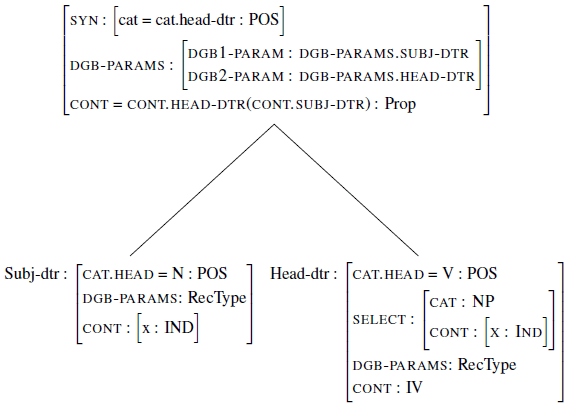
A concrete example is provided in (22b): the NP daughter in (22b) exemplifies a lexical entry for a proper name, as in (20a). Whereas the head daughter exemplifies a phrasal description for a VP whose content is a function from (records providing) individuals to propositions, which is (19a), with the subject argument x lambda-abstracted away: :
- (22)
- a.
- Dali scores a goal
- b.
3.3 Denotational considerations
What is the denotational status of wh-exclamatives? There is evidence from both direct, root uses, and embedded uses. As for the former, one often finds claims that an utterance of an exclamative does not appear to make a contribution to discourse which can be denied or affirmed directly (Rett 2011), and that they cannot be used to answer questions (Zanuttini & Portner 2003; Marandin 2008; Siemund 2017).
However, such assumptions are challenged by data from recent and not so recent works. Ginzburg & Sag (2000) provide (23a) and Miró (2008) (23b) to illustrate the fact that exclamatives can be challenged naturally, whereas Abeillé & Godard (2021) provide (23c) to illustrate that they can give rise to confirmation:
- (23)
- a.
- Watson: What a queer, scrambling way of expressing his meaning! Holmes: On the contrary, he has done remarkably well. (The Valley of Fear, A. Conan Doyle.) Ginzburg & Sag 2000: ex. (48)
- b.
- A: How tall Bill is! B1: # That’s not true, you are not emotional. B2: Come on, he’ s not that tall. Miró 2008: (27)
- c.
- Comme
- How
- nous
- we
- aimons
- love-1pl
- les
- the-pl
- amis
- friends
- qui
- that
- viennent
- just
- de
- nous
- us
- quitter,
- left
- n’est-ce
- isn’t-this
- pas
- not
- How we love our friends who have just died, isn’t that so? Abeillé & Godard 2021: §86
Ginzburg (2019) provides dialogue data with wh-exclamative sluices (though clearly this would apply also to the correspondingly synonymous wh-exclamative clauses) to illustrate the possibility that exclamatives can be used to answer questions:
- (24)
- a.
- A: What would you say about this new guy Spinks? B: oh boy! What an artist! A: Really? I’ve heard other things.
- b.
- A: How was the party? B: What a disaster! A: It was that bad? B: Oh yes.
- c.
- A: What happened at the debate? B: Jacob Rees-Mogg rose for the government. What a disaster!
- d.
- A: How was the goal? B: Oh well, what a shot!
Recent work by Trotzke and collaborators (Trotzke & Villalba 2020; Trotzke & Giannakidou 2021) argue in some detail for the assertoric nature of exclamatives and, as above, for the possibility of using exclamatives as responses to questions.10 Thus, Trotzke & Giannakidou 2021: (14)–(15) offer (25), contrasting (25a) where the exclamative seems infelicitous and (25b) where the exclamative is felicitous. They suggest that the infelicity of the former is due to the question there asking directly what the degree of fastness was, whereas the exclamative involves a presupposition of the speaker’s belief of the extreme degree of fastness; our account of the force of exclamatives in section 4.3 attempts to capture this insight.11
- (25)
- a.
- A: How fast was Eliud Kipchoge? B: Eliud Kipchoge was [very]F fast. B’: # [How fast Eliud Kipchoge was!]F
- b.
- A: Tell me, how did Eliud Kipchoge do in the race? B: [He was very fast.]F B’: My god! [How fast he was!]F
Trotzke & Villalba (2020) provide experimental data from German and Catalan concerning a contrast between that-exclamatives and wh-exclamatives: whereas subjects accept the former as a felicitous response to a polar question, in similar contexts they find infelicitous corresponding wh-exclamatives, which we have shown can above can be used as responses to wh-questions.12
Rett (2011) proposes to associate exclamatives with a denotation as properties of degrees. This has the potential virtue of explaining why exclamative clauses are not multi-functional, but can only be used to exclaim, which for Rett (2011) amounts to violation of the speaker’s expectations. However, the lack of multi-functionality can be queried, as we suggest in section 4.3, and in fact our explication of exclamation there seems to tie in in a more direct way to exclamative content without postulating type difference. The expectation one has when postulating a new semantic type is that there will be a special class of predicates which select solely for this type, as is the case for questions (ask, wonder, investigate,…), imperatives (named outcomes by Ginzburg & Sag (2000), projective propositions by Portner (1997)) (order, command, require,…) and so on. But this is not the case here—the predicates selecting exclamative clauses are typically factive, as in (26):
- (26)
- a.
- Jo finally discovered what a runner Dana is.
- b.
- Merle knows how incredibly well Merle did in the elections.
- c.
- Brendan forgot what an artist Dana is. Ginzburg & Sag 2000: Chapter 3, examples (47a-c)
This, more than anything else, we think, is what has led to the assumption that exclamatives are somehow presupposed (Zanuttini & Portner 2003) or fact–denoting (Ginzburg & Sag 2000). Marandin (2008) has argued against the factivity of exclamatives on the basis of examples such as (27):
- (27)
- Marie admire beaucoup Vergez. Elle m’a encore répété hier combien / ce qu’ il avait été bon dans le procès Dupond. Pourtant, je sais qu’il n’a pas été bon dans cette affaire. Marandin 2008: Example (12)
- Marie admires Vergez a lot. She told me again and again how brilliant he was in the Dupond affair. Yet, I know that he was not brilliant in that case.
Such examples can also be constructed in English. (28a) does not require us to accept that Boris is a great leader and the same applies mutatis mutandis for (28b); in (28c) the exclamative is attributed as the content of declarations by preachers, but the sentence following it expresses doubt about its validity. (28d) exemplifies an embedded exclamative with the non-factive, intrinsically propositional verb ‘think’ and (28e) with the equally intrinsically propositional verb convince:
- (28)
- a.
- Belle has been going on and on about what a great leader Boris is.
- b.
- Jo tried to convince me what a fine, virtuous leader Nero had been.
- c.
- The offices faced out on to the wolf enclosure and as he looked at the pack huddled by the iron fence in the snow he thought how right they looked for once. (Callanish, BNC)
- d.
- Plumb tried to convince me how wrong/what a mistake it had been to dethrone the rightful sovereign. (Slightly modified from Politics under the later Stuarts: party conflict in a divided society, 1660–1715., BNC)
The data in (28) suggest that exclamatives have non-factive uses and complements the earlier data in suggesting that exclamatives have propositional uses. The data is clearly subtle: convince is more or less synonymous with cause-to-believe, hence indeed (29a) seems felicitous; whereas Ginzburg & Sag (2000) explicitly argued on the basis of examples (29b) that propositional predicates such as believe are incompatible with exclamative clauses; we do not at present have an explanation for the contrast between (29a) and (29b), nor for the reason why ‘such N’, very close in meaning to wh-exclamatives, seem entirely compatible with such predicates.
- (29)
- a.
- Plumb made me believe how wrong/what a mistake it had been to dethrone the rightful sovereign.
- b.
- #Jo believes/claims what an artist Dana is. Ginzburg & Sag 2000: Chapter 3, example (46c)
- c.
- Jo believes/claims Dana is such a great artist.
Whether this can, in part, be explicated on the basis of the auto-evidentiality, which Marandin (2008); Siemund (2017) associate with exclamatives and which emerges on our account at least for first person root uses (see below section 4.3), we leave as a question for future research, which must clearly be based on detailed corpus and experimental investigation.
The strategy we will follow denotationally is to assume that exclamatives directly denote propositions, following Marandin (2008) in this respect, and obtaining factive denotations, for instance via the strategy of Ginzburg & Sag (2000), namely a rule building fact–denoting denotations from propositional ones (see Ginzburg & Sag 2000: (38a), Appendix A
3.4 Scaling up
Michaelis & Lambrecht (1996) propose that “exclamative utterances are those in which the speaker presupposes that some entity is located at some point on a property scale, and asserts that the entity manifests a remarkably high degree of this property.”13 While our explication of exclamation will be somewhat different, we take this high degree on a scale, along with much of the recent literature on exclamatives (Ginzburg & Sag 2000; Marandin 2008; Rett 2011; Castroviejo 2021), as the semantic contribution of the exclamative determiner. Our view of exclamation, developed in section 4.3, relates it to arousal, which can be positively or negatively valenced. For some words the scale’s polarity seems—putting ironic uses aside—fixed, as in (30a,b) respectively but in other cases the polarity is fixed by the speaker’s intentions and additional cues are needed, e.g., intonation and facial gestures:
- (30)
- a.
- Positive: What joy!, What a hero!
- b.
- Negative: What a disaster!, What a tragedy!
- c.
- Underspecified: What a goal! (speaker can be highly impressed or highly annoyed, for the latter, say, given that it arose through the ball hitting the goalkeeper’s back.); What a painting! (speaker can be highly impressed or exasperated)
Hence, we assume that the type Scale partitions into PositiveScale and NegativeScale relating to valence. We assume, nonetheless, that both the degree and the scale are described not referential, since presumably equivalent exclamative utterances can be made with distinct scales, though nothing much rides on this. Hence, we introduce the following predicate, typed as a property modifier as stated in (31a) and whose witnessing conditions are given in (31b):
- (31)
- a.
- ScaleUp : (IV)IV
- b.
- e : ScaleUp(P)(x) iff for some δ : degree, s : Scale: P(x,δ) and High(δ,s) hold
3.5 Exclamative sluices
As we mentioned earlier, we reuse the HPSG syntactic analysis of exclamative phrases from (Ginzburg & Sag 2000; Sag 2010), but modify the semantic analysis therein. (32) is a lightly modified lexical entry for the lexical entry what a (based on Sag 2010: (69)):14 this lexical entry indicates that what a is a determiner that selects for a common noun phrase; the feature wh is used to regulate the distribution of wh words—its use will be explained when we show how to block “in situ” occurrences in exclamative clauses in section 3.6 while allowing in sluices:
- (32)
This builds the wh-exclamative phrase by functional application. We will refer to this phrase type, which is an instance of a determiner-CNP construction and which occurs both in exclamative sluices and in exclamative clauses as wh-exclP:
- (33)
- wh-exclP
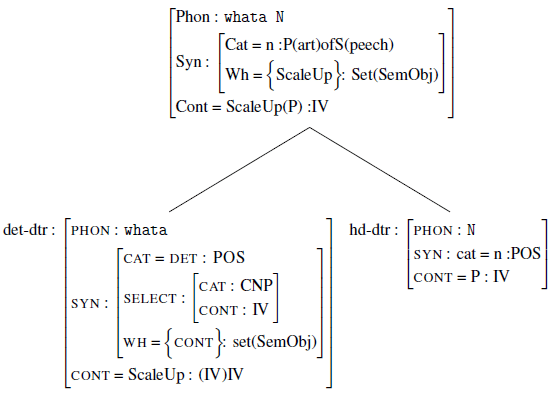
Given this, our analysis of exclamative sluices is very simple: on our account, they involve predication of a scaled up property P (in the sense of the previous subsection), originating from the head noun (group), of a contextually given individual z. In other words, this is a straightforward predication—modulo the scaling up of the predicate—on a contextually supplied entity, one that needs to be exclaimable—accessible in context for an exclamation, in a sense we develop in section 4.2. We will later see other types of NSUs, not involving wh-exclamative phrases, with a very similar analysis.15 We postulate the type in (34a) to analyze exclamative sluices; given the definition of ScaleUp, the truth conditions of such sluices are given in (34b); – what is specific here to exclamatives sluices is merely the meaning of the predicate; the fact that the mother is specified as wh = { } is a general characteristic of root clauses;16 (34c) exemplifies such an analysis for ‘What a goal!’:
- (34)
- a.
- wh-nom-excl-sl =def
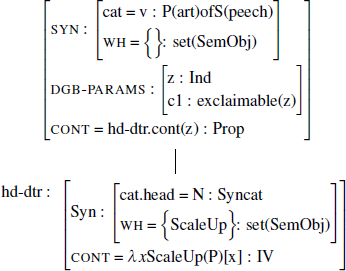
- b.
- For exclaimable z, there exist δ : degree, s : Scale: P(z,δ) and High(δ,s)
- c.
Entirely analogous comments apply to the adjectival exclamative sluices.17 We could subsume them within the type specified in (34a) simply by widening the specification of the element selected by the determiner to be Adj ∨ N. However, if we wish to capture our earlier observation that such exclamative sluices are restricted to be situational entities, we could posit an additional construction wh-adj-excl-sl as in (35a), subsequently exemplified in (35b):
- (35)
- a.
- wh-adj-excl-sl =def
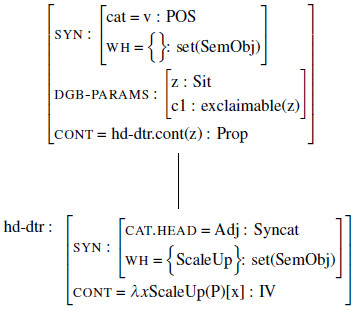
- b.
Although we have dubbed our construction wh-nom-excl-sl, for better or worse, it is quite general and can be extended with one small modification to other non-wh exclamatives, the need for which has been suggested in earlier work, e.g., (Michaelis & Lambrecht 1996; Rett 2011) This applies most clearly to phrases headed by such: in non-sentential cases what a N and such a N and a Adj+N seem quite interchangeable. (36a,b) are from a comments’ section reaction to an obituary for the distinguished linguist Anne Cutler; (37a-d) are from social media tweets, reacting to the release of the Ukrainian medic Yulia Payevska; (37e) is an exclamative use of an indefinite:
- (36)
- a.
- A great loss to the field.
- b.
- What a loss. What a sharp (in the best sense), spicy person and linguist. She brightened our lives and also the field.
- https://languagelog.ldc.upenn.edu/nll/?p=54957
- (37)
- a.
- Such a relief to hear! I had been worried for her safety. I hope she will be okay going forward. Such a hero!
- b.
- Good news, congrats on your release. What a relief!
- c.
- What great news! Been really worried about her!!
- d.
- Such a relief ! So glad for her and her family and friends.
- https://twitter.com/olgatokariuk/status/1537867412196007937
- e.
- Nadal pulls off a truly incredibly recovery from 1–5 and match point down. A miraculous performance. (The Guardian, Nov 13, 2019)
We can associate virtually the same lexical entry with such as with what a, modulo the Wh feature specification. For non-sentential uses, this will lead to equivalent contents. However, with respect to clausal uses, the fact that such has an empty specification for Wh will allow it to appear in situ, as discussed in section 3.6. We will not offer an explicit account of indefinite exclamative uses here, but hypothesize that it can be constructed by the effect of focus on adjectives in such phrases.
- (38)
In light of this, we can postulate a generalized non-sentential exclamative construction, differing only from (34a) in that the hd-dtr is specified as optionally non-empty for the feature Wh:18
- (39)
- nom-excl-sl =def
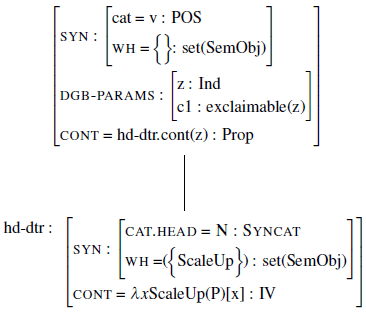
3.6 Analyzing wh-exclamative clauses
As with the lexical specification of exclamatives, the syntactic analysis for wh-exclamative clauses we utilize reprises the analysis in (Ginzburg & Sag 2000; Sag 2010). On that analysis, a wh-excl-cl is a filler-gap construction; the only additional syntactic specifications are that (i) the construction is not inverted and (ii) that the filler daughter, has a non-empty specification for the feature wh—its value being the ScaleUp operator; (iii) the filler daughter is specified as non-verbal, given that it can be an NP, AP, AdvP, or (gradable) PP, but not a VP Sag 2010: examples (76).
As far as the content goes, it involves two conditions, or equivalently a conjunction: one condition is the scaled up property coming from the filler daughter. This is, with one important caveat, identical to the content in wh-excl-sl-cl, and will be the basis of our account of incremental (word–by–word) understanding of exclamative clauses. The other condition is an additional restriction emanating from the head-dtr. However, we assume that, in contrast to wh-excl-nom-cl, the subject of this predication is existentially quantified away, rather than contextually supplied. This is in line with the general semantics of filler-gap constructions. It also allows us to offer an explication of the data from (10, 11) wherein exclamative clauses allow for scopal dependence, whereas exclamative sluices do not.
The specification of wh-excl-cl is in (40a) and an example is provided in (40b), which is the “scaled up” version of (22):
- (40)
- a.
- wh-excl-cl =def
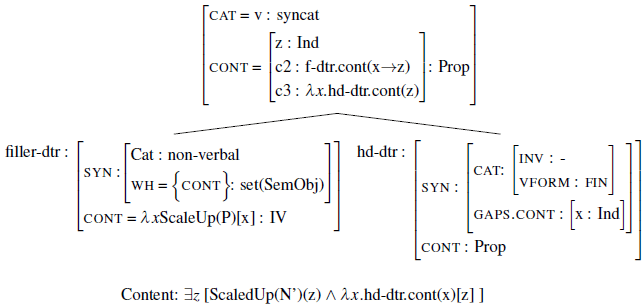
- b.
3.7 Some simple consequences
3.7.1 Clausal and sluiced synonymy
Perhaps the most basic prediction of our account is that we capture the essential synonymy of (41a) and (41b) with appropriate contextual resolution, i.e., predication of the referent of the pronoun ctxt-ref:
- (41)
- a.
- What a N!
- b.
- What a N s/he is!
The basic inference is given in (42):
- (42)
- a.
- What a N ⟼ ScaleUp(N’)(ctxt-ref)
- b.
- What a N she is ⟼ ∃z.[ScaleUp(N′)(ctxt – ref) ∧ λx[= (ctxt – ref,x)](ctxt – ref)] ↝ ScaleUp(N’)(ctxt-ref)
3.7.2 Incrementality
Our proposed treatment of exclamative clauses in conjunction with our treatment of exclamative sluices is quasi–incremental (Schlesewsky & Bornkessel 2004). That is, it allows to explain why an exclamative clause can already be (partially) understood as soon as the wh-excl is uttered—there is already at that point a complete exclamative predication. While we are not aware of any experimental work on this score, akin to (Urbach et al. 2015), which shows that QNPs are interpreted incrementally, we put this forward as a plausible hypothesis.
On an account of incremental interpretation such as (Ginzburg et al. 2016), after processing What a N …, one can postulate a content where the projected but as yet unuttered constituent u1 contributes its content in an existentially quantified form. For (40), this would yield (43a) or equivalently (43b).
- (43)
- a.
- b.
- ∃z,P[ScaleUp(N)(z) ∧ P(z)]
Such cases are problematic for accounts such as (Rett 2011; Castroviejo 2021) which tie wh-exclamative interpretation to QR and to most accounts that assume the wh-exclamative to be a generalized quantifier e.g., (Ginzburg & Sag 2000; Marandin 2008; Sag 2010).
3.7.3 In situ distribution
We can now turn to explain how one rules out cases like (44a), while allowing in cases like (44b). Such cases are also problematic for accounts such as (Rett 2011; Castroviejo 2021) which tie wh-exclamative interpretation to QR, since in cases like (44b) there is no apparent sentential source:
- (44)
- a.
- *Dali scored what a goal!
- b.
- (Context: Dali is observed scoring a goal) What a goal!
The feature wh was introduced in Ginzburg & Sag (2000) as a means for regulating the distribution of whPs. As Ginzburg & Sag 2000: pp. 231–2 explain with respect to pied-piping: “What is required is a way of guaranteeing that the constructional WH requirement trickles down appropriately through a filler daughter like the one shown in (40) to ensure that there is an embedded wh-word with the appropriate WH specification … whenever a WH-specified word (one with a non-empty value for WH) is present, its WH specification is passed up through the tree so as to WH-specify phrases that contain that WH-specified word as well. Conversely, it must follow that when no wh-word is present within a given phrase, that phrase must be WH : { }, and hence unsuitable as a filler daughter in a wh-construction.” This is the basis of a detailed account of both pied-piping and wh-in-situ constructions. In their system any XP occurring in situ must have as their value the empty set19 –interrogative WhPs come in two varieties, ones specified as bearing a non-empty value for wh, and those specified as bearing as their value the empty set, a distinction that is also phonologically motivated. Exclamative WhPs are obligatorily specified as bearing a non-empty value, which blocks their potential to occur in situ see Ginzburg & Sag 2000: Examples (66a-d), Chapter 5. In contrast to the current account, building on that of Ginzburg & Sag (2000), where Wh-meaning and dislocation are independent, an account of wh–exclamative phrases tied to movement is challenged by exophoric cases, since it requires some mechanism to provide a trace for the wh–operator. An account like the current one has no such problem—the construction specifies the “termination” of the wh–specification by the mother of the construction, as in (39), as applies to all non-sentential utterance constructions.
Whether or not there is a deeper explanation for the inability of wh–exclamative phrases to occur in situ in exclamative clauses, we suspect that it does not derive directly from their exclamative meaning, given that this pattern is not replicated with other non-wh exclamative phrases such as such N:20
- (45)
- a.
- Dali scored such a (great) goal!
- b.
- Such a (great) goal Dali scored!
On our account ‘such’ is specified as wh : { } (see the lexical entry in (38)), hence there is no difficulty to explain (45a)—the suchP is selected as the object of the verb ‘score’. (45b) is analyzed as an instance of topicalisation from (Sag 2010) ((61),p. 512): the content arises by substituting the filler daughter’s content into the gap position’s argument role; the construction is also specified to be I(ndependent)C(lause):+ which ‘permits topicalized clauses to function as root clauses and also allows them to appear in embedded environments where main-clause phenomena (those specified as [ic:+]—authors) are allowed.’ (loc cit, (Sag 2010)):
- (46)
- Topicalization-cl =def
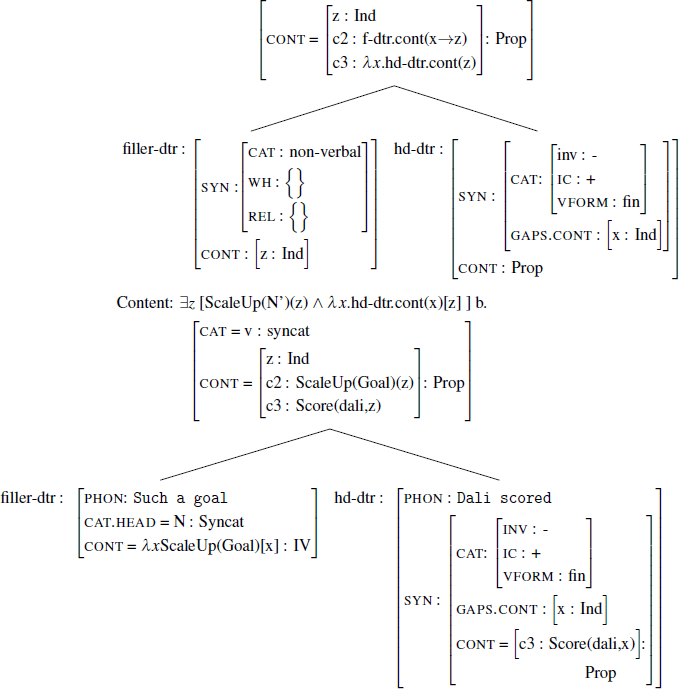
This makes the correct prediction that dislocated such exclamative clauses, in contrast to wh exclamative clauses, cannot be embedded:21
- (47)
- a.
- *Jill revealed to me (that) such a (great) goal Dali had scored.
- b.
- Jill revealed to me (that) Dali had scored such a (great) goal.
- c.
- Jill revealed to me what a (great) goal Dali had scored.
- d.
- *Jo showed me (that) such a dirty look Frank had given her.
- e.
- *Jo showed me (that) Frank had given her such a dirty look.
- f.
- Jo showed me what a dirty look Frank had given her.
3.8 Interrogative/Exclamative complementarity
On our account the exclamative sluice is built from an exclamative determiner and a common noun phrase. More specifically, we assume that certain wh words, specifically those that are syntactically determiners, can function as exclamative determiners. There is some cross-linguistic variation on this score, depending at least in part on the richness of the morphological inventory of the language. Thus, in English what can function as both as an interrogative and as an exclamative determiner, whereas which can only function as an interrogative determiner, as illustrated in (48a,b):
- (48)
- a.
- What students showed up (!/?—ambiguous between interrogative and exclamative reading)
- b.
- Which students showed up (?—only interrogative reading)
In contrast, in French, which has a single noun–selecting wh—determiner, both interrogative and exclamative uses are possible Abeillé & Godard (2021). Note that this data provides an argument for the independence of interrogative and exclamative meaning: accounts that assume that exclamatives are derived by some semantic or pragmatic operation from questions, e.g., (Zanuttini & Portner 2003) are challenged by (48).22 Indeed in Modern Hebrew both exclamative determiners, eyze and kama, have uses as a quantifier, an interrogative, and an exclamative, as exemplified in (49), thereby raising the question which meaning is basic:23
- (49)
- a.
- kama
- Several/How many
- yeladim
- child-pl
- azvu(./?/!)
- left
- Several children left./How many children left?/!
- b.
- eyze
- Some/Which/what
- yeladim
- child-pl
- azvu(./?/!)
- left
- Some children left./Which children left?/What children left!
Relatedly, we note the existence of a variant of the exclamative clause How S!, restricted to how which lacks an adjective and means ‘S a lot/much.’. We assume this can be analyzed like French comme–exclamatives, where Marandin (2008) has analyzed comme as an exclamative complementizer which scales up the main relation associated with S. This does not allow for a bare exclamative reading, nor can this hold for How much or What—our exclamative sluice construction (34) requires a common noun to supply the property which is scaled up.
- (50)
- a.
- A: His performance was pathetic. How we laughed!/ B: Yeah, how comical! / B: #How!/ #How much!
- b.
- A: He is a real idiot. B: Yeah, what an idiot!/#What!
4 Exclamative Sluices in context: resolution and exclamation
In this section, we sketch an account of how exclamative sluices get resolved and what exclaiming amounts to. In order to do so, we first provide some background on context in dialogue, using the KoS framework (Ginzburg 2012), which has been used extensively for non-sentential utterance resolution.
4.1 Dialogue GameBoards
The simplest model of context, going back to (Montague 1974), is one which specifies the existence of a speaker, addressing an addressee at a particular time. This can be captured in terms of the type in (51), which classifies situations (records) that involve the obvious entities and actions.
- (51)
However, over the last four decades it has become clearer how much more pervasive reference to context in interaction is. The visual situation is a key component in interaction from birth, playing a major role in interlocutor attention (Mundy & Newell 2007). Expectations arise due to illocutionary acts—one act (querying, assertion, greeting) giving rise to anticipation of an appropriate response (answer, acceptance, counter–greeting), also known as adjacency pairs (Schegloff 2007). Extended interaction gives rise to shared assumptions or presuppositions (Stalnaker 1978), whereas uncertainty about mutual understanding that remain to be resolved across participants—questions under discussion (QUD)—are a key notion in explaining coherence and various anaphoric processes (Ginzburg 1994; 2012; Roberts 1996). These considerations among several additional significant ones lead to positing a significantly richer structure to represent each participant’s view of publicized context, the dialogue gameboard (DGB), whose basic make up is given in (52); the dialogue gameboard together with the private part make up the total cognitive state (TCS) of an interlocutor, though in our discussion here we will almost exclusively concentrate only on the dialogue gameboard.
- (52)
Here facts represents the shared assumptions of the interlocutors—identified with a set of propositions. Dialogue moves that are in the process of being grounded or under clarification are the elements of the pending list; already grounded moves are moved to the moves list. Within moves the first element has a special status given its use to capture adjacency pair coherence and it is referred to as LatestMove. The current question under discussion is tracked in the qud field, whose data type is a partially ordered set (poset). Vis-sit represents the visual situation of an agent, including his or her visual focus of attention (foa), which can be an object (Ind), or a situation or event. Mood, which we discuss in more detail below, tracks a participant’s public displays of emotion, crucial for inter alia laughter, smiling, and sighing Ginzburg et al. (2020).
Dialogue regularities are captured in terms of conversational rules, mappings between two cognitive states the precond(ition)s and the effects. For exclamatives which we have argued to be propositional the following rules play a role in subsequent explication:
- (53)
- a.
- Assert/Ask QUD-incrementation: given a proposition p (question q) and ASSERT(A,B,p)(ASK(A,B,q)) being the LatestMove, one can update QUD with p? (q) as MaxQUD.

- b.
- QSPEC: “Relevance maxim” – if q is MaxQUD, then subsequent to this either conversational participant may make a move constrained to be q-specific (i.e., either About or Influencing q).
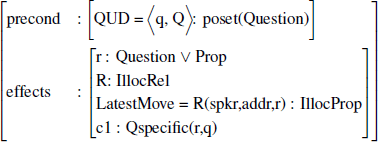
The rules in (53) are all participant neutral distinguished from rules that are specified only for particular interlocutors (participant sensitive). The latter kind of specification is, in principle, more general and particularly relevant to potentially asymmetric phenomena like perception and exclamation. Their basic format is as in (54), here the rule applies to the dialogue gameboard of current speaker, with the obvious change in the case where it applies to the current addressee; recall that the dialogue gameboard together with the private part make up the total cognitive state (TCS). One of the rules we specify for exclamation will be of this form.
- (54)
Grammar and dialogue context interface in descriptions of signs via the feature dgb-params, which allows the DGB to instantiate elements of the content.
4.2 Resolving exclamative sluices
How then can we describe the notion of Exclaimable, which we used in our rule for exclamative sluices in this view of context? Using the view of context based on the DGB offers a plausible starting point:
- (55)
- a.
- RQUD—The most recent linguistically expressed proposition (RQUD): this class of antecedents can be characterized as the maximal element of QUD—MaxQUD.
- b.
- RRef—A recent referent or entity present in the context: this class of antecedents is harder to characterize. They seem to include all potential antecedents for a third person pronoun, as well as the speaker (A: I left my keys at home. What a genius!) and addressees (e.g., (8c)). For this class, a potential characterization is the one proposed in Ginzburg 2012: Definition (116), p. 335 for pronouns in dialogue. On this view, an antecedent for a pronoun is to be sought in an active move, a notion inspired by the discourse structure notion of the right frontier constraint (Hunter et al. 2015): the ‘right frontier’ is constituted by elements of QUD, answers to such (topical facts), and utterances under grounding/correction.
- c.
- ExInf—Exophoric or inferred eventive or propositional antecedent: this class, as we have emphasized earlier, is heterogeneous, including as it does directly perceptible audio/visual entities whether individual or eventive (See (7a,c,d) for the former, (7b,e,f) for the latter), as well as inferentially obtained propositional entities (e.g., (8a)). For the audio/visual entities, we can offer a characterization in terms of being either the visual situation or its focus of attention.
Thus, we hypothesize that Exclaimable can be characterized disjunctively in terms of the three sub-characterizations in (55).
4.3 Exclaiming in dialogue
The final component to an account of exclamatives is an account of exclamation. The account we sketch here is situated within current appraisal–based (Scherer 2009) and constructionist (Russell 2003) theories of emotion and is based on increased arousal. This contrasts with a more epistemic approach advocated by Rett (2011), where exclamation is explicated in terms of a clash with previous expectations.24 We will not engage in detail here with the latter approach beyond noting previous critiques that point out various exclamative uses that do not involve such a clash, e.g., (56), a minor variant on an example due to Zanuttini & Portner (2003)—this can be uttered without implying that it is surprising that such a cake could be made by the addressee:
- (56)
- What a nice cake you’ve made!
Before spelling out the emotive contribution, we emphasize one consequence of our postulating that exclamatives have a propositional denotation. Hence, they effect a propositional update like ‘canonical declaratives’—they can trigger agreement, discussion, or incomprehension, exemplified by (23a) repeated here with added alternative utterances:
- (57)
- Watson: What a queer, scrambling way of expressing his meaning! Holmes: On the contrary, he has done remarkably well. (The Valley of Fear, A. Conan Doyle.) / Holmes: Indeed./ Holmes: In what way?
But in addition what marks them out is that they also effect a mood update, which we sketch here. The current sketch has the virtue of being tied to independently motivated notions of emotion and to capture the auto-evidentiality associated by some authors with exclaiming (Marandin 2008; Siemund 2017), providing a more refined notion than factivity or presupposition.25
Appraisal-based approaches view emotional episodes in terms of appraising events an agent perceives in relation to their ongoing concerns. An initial automatic appraisal takes place that does not require conscious processing. This is followed by a secondary appraisal that often includes conscious reflection and that can lead to new intentions. An exclamation involves the agent publicizing their increased arousal as a consequence of an appraisal. In this, they resemble non-verbal signals like laughter, smiling, and sighing—on the account of Ginzburg et al. (2020) laughter, for instance, involves increased positively valenced arousal as a consequence of an event being appraised as being incongruous; Lücking & Ginzburg (2021) suggest that head shakes can arise due to a negatively appraised event, often expressed using linguistic negation (Potts 2010). Our proposal is that (root uses of) exclamatives involve increased arousal, underspecified to be positively or negatively valenced, as a consequence of an event being appraised as involving a ScaleUp predication. Since ScaleUp predications often involve situations that are at least mildly incongruous, this leads to the expectation that exclamations will be accompanied by smiles or laughter (in positively valenced cases) and head shakes or sighs (in negatively valenced cases). An expectation, which corpus data such as (58), repeated from (7) in section 2.1.2 (with initial context occasionally trimmed for space reasons) seem to support, though of course this hypothesis requires careful experimental and corpus investigation. In (58) bold-faced non-verbal actions or expressions of explicit emotion are actually occurring tokens, whereas italicized ones are hypothesized actions, which seem felicitous:
- (58)
- a.
- Miss Potts looked so disbelieving, Mademoiselle exaggerated the size of the spider and held out her hands to show Miss Potts it was at least as big as a fair sized frog. The girls had enjoyed everything immensely. What a French lesson! (BNC)
- b.
- (Context: New Conversation) Madge: What a lovely garden! (smile) Anon 4: Hello Jean! Anon 1: Isn’t it? That’s what I was saying. (BNC)
- c.
- Two arms swooped on the seaman and carried the fellow away. Captain Nemo leaped outside. We rushed after him. What a scene ! (snigger) (COCA)
- d.
- Kitty: Martin came home and said oh is that Mark fro Mark from Woking? I thought, (laughing):[ ah, ha ]! Anon 4: The wrong bloody number. Kitty: Oops! Yeah. But honestly, how stupid! (BNC)
- e.
- A: I had free tickets for Caligula B: [mhm] A: you know it they arrived suddenly and that was that b: when was this then? A: it was for Saturday b: oh what a pity! (shakes head) I went home for the weekend. (London Lund Corpus)
How to integrate notions of arousal in the grammar? As we mentioned earlier, Ginzburg et al. (2020) proposed to incorporate the effect of both typically positively valenced signals such as laughs and smiles, typically negatively valenced ones like frowns, and ambiguously valenced ones like sighs on an interlocutor’s public face in the DGB in terms of an additional repository mood—a weighted sum of appraisals. Thus, at any given time mood is of type Appraisal, this structure inspired by the Circumplex Model of Emotion of Russell (2003) and Scherer’s Component Process Model (CPM) of appraisal Scherer (2009):
- (59)
(59) represents the current degree of felt pleasantness publicly displayed by an agent. This can be either a positive real (ℝ) number (pve, pleasant), a negative real (ℝ) number (nve, unpleasant) or both (ambivalence). It also represents via powerful the agent’s degree of self-control and the event/individual responsible for the most recent appraisal.
(60) is a conversational rule that explicates how to update pleasantness within mood: this involves incrementing by δ the positive pleasantness given a weighting 0 ≤ ɛ ≤ 1 between the new value and the existing value;26 the converse operation of incrementing the negative pleasantness is entirely analogous with the obvious permutation on the pve/nve values mutatis mutandis:
- (60)
Given this we can specify update rules that tie exclamations with scaled up predicates to arousal updates. (61) indicates that given an exclamation of a scaled up predication, where the degree is δ, this leads to a pleasantness incrementation for the exclaimer. Hence, this is what we called earlier a participant sensitive conversation rule. We distinguish two valences of exclamation, as discussed in section 3.4, which we assume are a function of the scale associated with the scaled up predication. Hence, we underspecify the valence using the function PolPleasantnessIncr, specified in (61b): positive exclamation leads to a PositivePleasantnessIncr as in (60a), whereas negative exclamation leads to a NegativePleasantnessIncr as in (60b). Our conversational rule also makes reference to a scaling coefficient σ that depends on the scale s. The scaling coefficient is necessary to adjust δ from the original scale s (deriving from a noun or adjective) to the scale of pleasantness. In the simplest case conceivable case the scales are simple partitions into a small number of values which could be, say, Low, Mid, High, for both and then σ = 1, but this will not generally be the case.
- (61)
- ScaleUp-based exclamation
- a.
- b.
We exemplify this and its interaction with the conversational rules introduced earlier in (62). A asks the question (1), which triggers an update of QUD; this licenses B’s response (2) via the conversational rule QSpec; this, in turn, triggers an update of QUD and an update of Mood, which given the negative valence of ‘disaster’ will be NegativePleasantnessIncr. We assume, for simplicity, that the initial values of both pleasant.arousal.nve and pleasant.arousal.pve are 0 and that ɛ, the Mood update weight is .25 and that δ the expressed arousal is 3. Hence, the latter arousal remains 0, whereas the former arousal is modified, as per (60c):
- (62)
- a.
- (1) A: How was the debate? (2) B: What a disaster!
- b.
- (1).content = q0 = λ P.[c1 : P(debate0)];
- (2).content = p0 = [c1 : ScaleUp(Disaster)[debate0]]
- c.
The conversational force associated with exclamatives is, like other assertoric moves, an underspecification of various more specific moves which require more detailed analysis, which we cannot provide here: e.g., praise/thank on the positive side and criticize/complain on the negative, as also noted by Rett (2011):
- (63)
- a.
- What a wonderful talk! (Praise)
- b.
- What a kind gift! (Thanking)
- c.
- What a stupid proposal! (Criticism/Abuse)
- d.
- What a terrible night in the hotel! (Complaint)
Finally, we note that the rule in (61) is formulated for better or worse for scaled up predicates. For better in that it ties in exclaiming to ‘extremal predication’. For potentially worse given cases like (64) where there need not be a scaled up predicate:
- (64)
- a.
- A: OMG, United have won the cup!
- b.
- The King has been deposed!
One way that these can be viewed as involving scaling up is via the assumption that as thetic utterances they involve accommodation of a general issue such as ‘What happened’ ((Vallduvì 2016: p. 738)). Hence, they can be construed as being short answers to that question, where the associated predicate is scaled up.27
5 Comparing the resolution process for Excl-sluices and Interrogative Sluices
In this final (pre-concluding) section, we compare the resolution possibilities of exclamative sluices and (direct) interrogative sluices28 specifically with respect to exophoric resolution and the difference in the potential for such uses. We think that the dialogical constructionist account formulated here has a straightforward account; for an earlier and highly detailed account of the potential for exophoric uses of VPE in terms of certain discourse conditions see (Miller & Pullum 2012). We emphasize that, as discussed in (Ginzburg & Sag 2000; Ginzburg & Miller 2019) in a dialogical constructionist view there is in general nothing special about exophoric uses for NSUs or VPE—in all cases the content of the constructions involves semantic objects from the conversational context; exophoric uses are simply cases where these objects are not (constituents of) the content of a (recent) utterance. We think that providing an account of the difference in exophoric potential is a significant challenge for deletion-reconstruction accounts, as we will explain below.
As we have seen, exophoric uses of exclamative sluices are pervasive. The semantics we assign them offers a direct explanation: the content assigned is a (scaled up) predication emanating from a common noun of a contextually provided referent. Hence, for any entity to which there exists a common noun that can predicate of it, an exophoric resolution of an exclamative sluice is possible if such an entity is perceptible. Hence, we get contrasts like in (65), moving on a cline from concrete to abstract. (65a-c) can all be exophoric ((65c) involves a complex event that participants might perceive over an extended period); however, (65d) seems much less likely to get an exophoric understanding because questions are difficult to evoke non-linguistically.
- (65)
- a.
- What a goal! (Potential for exophoric resolution)
- b.
- What a concert! (Potential for exophoric resolution)
- c.
- What an election! (Potential for exophoric resolution)
- d.
- What a question! (Reduced potential for exophoric resolution)
What of interrogative sluices?29 Sag & Hankamer (1984) suggested that exophoric resolution was not possible with reference to examples like (66a). Note that such examples are improved significantly if the sluice is modified by a ‘the hell’ type phrase and not embedded:
- (66)
- a.
- (Woman screaming in dark night) B:# I wonder who.
- b.
- (Man screaming in dark night) B: Who the hell?
In fact, exophoric resolution is possible, though it is much less productive than for exclamatives. It has been claimed to require some more or less scripted scenario (Chung et al. 1995). We think that this is probably an overly strong claim, given examples already cited in (Ginzburg & Sag 2000), repeated here as (67a,b). But this can be tested experimentally, in principle. We can, nonetheless, offer a straightforward explanation of this reduced exophoric potential.
- (67)
- a.
- A: I need some sugar for the cake.
- B: I think I bought some yesterday.
- A: [Searching through cupboards] Well, I’m skeptical. If you’re so sure, come show me where. ⟼ ‘Where the sugar is’.
- b.
- [Milling around on first day of conference, participants ignorant of location of talks go up to harried organiser:] Hey, could you tell us which room so we can go in and wait for things to start? ⟼ ‘Which room we need to go to’.
- (Ginzburg & Sag 2000: Chapter 8, examples (5a,b)
For this explanation, we need to have available a dialogical constructionist account of interrogative sluicing; we appeal to that developed in (Ginzburg & Sag 2000) and refined in (Ginzburg 2012). On that account, questions, the semantic denotata of interrogatives, are taken to be propositional functions, whereas wh-phrases are taken to provide the domains of such functions. In the case of sentential wh-interrogatives the filler daughter contributes the domain for the question; the range is identified with the content of the head daughter, with a substitution of filler daughter variable for gap variable. In the case of interrogative sluicing content is composed in an entirely analogous way, save for the fact that the queried proposition is supplied by context—it is the nucleus of a quantified proposition that constitutes Max-QUD—and the substitution is the sluice WhP daughter for the focus establishing constituent variable:30
- (68)
- a.
- Wh–interrogative clause ⟼ (WhP.dom)[Head-dtr.cont] (gap.var →WhP.var)
- b.
- Direct sluice ⟼
- (WhP.dom)[MaxQUD.q](fec.var →WhP.var)
- Where: MaxQUD : PolarQuestion
- WhP.cat = MaxQUD.fec.cat
- c.
- A: A student left; Makes ?∃x.[Student(x) ∧ Left(x)] MaxQUD;
- B: Whoz? ⟼ λz.[Student(x) ∧ Left(x)](x→z)
The difference between an exophoric and an endophoric resolution is straightforward: an endomorphic resolution is one where MaxQUD is the content of a recent element of MOVES, typically but not invariably LatestMOVE. An exophoric resolution, on the other hand, arises when MaxQUD arises by QUD accommodation (Larsson 2002), a process further detailed by Ginzburg (2012), Wong & Ginzburg (2018); Ginzburg & Wong (2023) for a variety of settings (shopping in a bakery or a railway station, a medical appointment etc). While this is a pervasive process, which leads to many exophoric resolutions for short answers, for interrogative sluicing what is needed is not any question, but a quantified polar question. These are difficult to construct non-linguistically. Hence, the large disparity in exophoric potential between interrogative and exclamative sluicing.
A sententialist, deletion–based account of exclamative sluicing is exemplified by Ono (2006), who attempts to extend the machinery developed by Merchant (2001) for interrogative sluicing. Can such an account offer an explanation of the difference in exophoric potential? We think not. On such an account the ellipsis is taken to be IP ellipsis and so there is no obvious way to distinguish the potential for antecedents.31
Other sententialist approaches can be entertained. For instance the following one proposed to us by an anonymous reviewer for Glossa. Such an account is inspired by combining two proposals: (a) the proposal of (Merchant 2004: p. 724) concerning exophoric understandings of NSUs in which these can be licensed when ‘the contexts are rich enough to make a certain entity salient …, and to make a certain question manifest’, and that this is restricted to matrix uses, and (b) the general strategy of recent sententialist QUD–oriented approaches, for instance Reich (2007); Barros (2014); Weir (2014); Griffiths (2019), who follow Ginzburg & Sag (2000) in assuming that NSUs are licensed by the MaxQUD. This strategy applies also to embedded uses.
According to this proposal, interrogative sluicing can arise out of both (a) and (b) strategies, whereas exclamative sluicing involves solely the (a) strategy, which is stipulated to be restricted to matrix uses—their resolution does not involve MaxQUD.
Obviously we cannot offer a serious evaluation of this sketch without seeing a formal proposal, both in terms of combinatorics and in terms of contextual resolution. There is, for instance, a technical question with respect to the (a) strategy—how both interrogative and exclamative sluices can be unified in one undifferentiated schema given the very different semantic properties of wh-interrogative and wh-exclamative phrases. Similarly, it is highly questionable that a single contextual characterization works to characterize the range of exophoric non-sententials.
Commenting impressionistically, we can observe the following: this proposal lumps exclamative sluicing into one, undifferentiated exophoric schema. One apparent motivation for this is dubious, specifically the assumption that exclamative sluices cannot make use of QUD (the proposition at issue) in resolution, as exemplified in (69):32
- (69)
- A: Someone stole my wallet. B: Who?/How annoying! What an outrage!
Moreover, such a proposal cannot capture the differences in resolution possibilities between what- and how- exclamative sluices discussed in section 2.2.
Does such a proposal capture the difference in exophoric potential between interrogative and exclamative sluicing? Potentially it could, given that it is, as the reviewer puts it, a sententialist reformulation of the current proposal—it does recognize that exclamative sluicing needs to be handled with a different strategy than the basic strategy assumed to apply to other elliptical constructions. Whether it is actually a sententialist formulation, as far as exclamative sluicing goes, requires an independent argument for assuming that exclamative sluices are phonologically reduced copular structures.
Having recognized the need for distinct resolution strategies, once one actually works out the details (to enable differentiation between what- and how- exclamative sluices, to get the contextual specification for exclamatives as distinct from other exophorics etc), we hypothesize that one ends up essentially with a constructionist system, like the one described in the current paper.
6 Conclusions and Future Work
Exclamative sluices are a non-sentential construction which turns out to be more common, often substantially so, than its clausal counterpart and whose resolution is, as we show in this paper, pervasively exophoric. Its profile contrasts with the constructions that have set the tone in the debate on the nature of ellipsis resolution, above all VPE and interrogative sluicing.
We provide here the first detailed, formal analysis of the content, resolution, and use of wh-exclamative sluices, which at the same time explicates their relationship with wh-exclamative clauses. We offer a number of arguments against analyzing the former as underlying variants of the latter, but our analysis also explains why exclamative clauses can be understood in online interpretation initially as exclamative sluices.
Along the way we:
provide evidence that exclamatives have a propositional denotation pace most of the existing literature, (but following Marandin (2008) and recent work such as Trotzke & Villalba (2020); Trotzke & Giannakidou (2021)).
sketch a formal characterization of dialogical resolution possibilities of exclamative sluices.
extend an account of exclaiming already applicable to laughter, smiling, and head shakes. This account provides a direct link between scaled up predication—the semantic contribution of exclamatives— and increased arousal, itself taken to involve scalar incrementation.
offer an explanation as to why exophoric uses are pervasive among exclamative sluices, but restricted among interrogative sluices. We believe this constitutes a clear explanatory advantage for a dialogically–oriented, constructionst account over a sententialist account based on deletion.
This paper is exclusively concerned with data from English and, hence, one important direction for future work concerns cross-linguistic investigation of exclamative sluices. A more detailed corpus study and fine-grained taxonomy of uses is also clearly required. Our hypothesis that exclamative phrases, like other quantified NPs, are interpreted incrementally awaits experimental testing. Extending coverage to provide a unified analysis with exclamative particles such as ‘My God’ and ‘Oh shit’ is also a clear desideratum.
Appendix
In this grammar, as in other work in the HPSG and Construction Grammar tradition, constructions are organized into a type hierarchy. This enables higher level types to be posited which allows relevant cross-cutting generalizations to be captured—for instance, all clauses whose type is subordinate to inter(rogative)-cl(ause) denote questions, whereas all types whose type is subordinate to hd-filler-ph(rase) have as their leftmost daughter a phrase that unifies with an extracted phrase in the head daughter. Conversely, certain specifications that are “idiosyncratic” and not applicable generally will only be stated at the lower level of the hierarchy, applicable perhaps to only one construction type. For extensive discussion see (Sag 2010).
The type hierarchy in Figure 1 collects the constructions posited in the current paper and situated them within a rudimentary type hierarchy, based on those in (Ginzburg & Sag 2000; Sag 2010). Straight edges represent subtypes, whereas wavy edges link types to (bold faced) instances.
Notes
- In saying there is no covert syntactic structure, there is no claim that syntactic information from context plays no role. Ginzburg & Sag (2000) and in particular Ginzburg (2012) have developed detailed accounts of various non-semantic parallelism effects between source and target in non-sentential utterances (NSUs). In fact, the latter work provides an explicit account of how syntactic information enters into conversational context and how reference to it is possible, an account which is not provided in deletion-based accounts. [^]
- As we discuss in section 5, there is also a recent approach in work on ellipsis that, while being sententialist, can be characterized as Questions Under Discussion (QUD)–based—it assumes, following the lead of Ginzburg & Sag (2000) that NSUs are licensed by the (maximal element of) QUD. [^]
- We use the term exclamative sluicing not in the “move and delete” sense originally intended by Ross (1969), but descriptively—the clear parallelism is that in both the interrogative and exclamative case there is a bare WhP that receives an interpretation as a complete utterance in the right context. The term sluicing has been used descriptively for the interrogative case (largely for historic reasons, we assume) even in accounts which eschew deletion e.g., (Ginzburg & Sag 2000; Barker 2013). [^]
- The actual utterance in this case, taken from a radio commentary in the London Lund corpus was: ‘What a clever stroke!’ [^]
- RQUD for ‘Recent QUD’—in other words, these pertain to the current QUD. More discussion of this in section 4. [^]
- This does require some inference from the actual sentence I can not stand still one moment longer in this wretched dress., but we will put that aside in trying to give an RQUD reading its best case. [^]
- Although we use English words to name these types, this is merely for convenience—they are intended as language and modality–independent real world notions. [^]
- Renamed here for reasons explained in section 4.1 d(ialogue)-g(ame)b(oard) parameter. [^]
- In order to facilitate readability for the uninitiated in TTR, the content of the VP which is a function from records r :
 into propositions has been notated as λx
into propositions has been notated as λx  rather than the more technically precise
rather than the more technically precise 
 We will continue employing such simplifying notation where no error can be imputed as a consequence.
[^]
We will continue employing such simplifying notation where no error can be imputed as a consequence.
[^]
- We thank an anonymous reviewer for Glossa for calling these papers to our attention from which also (23b) is drawn. [^]
- At the same time this is a rather subtle effect which can also be linked to the markedness of repeating a phrase with a different force, given that (i) seems considerably improved:
[^]
- (i)
- A: How fast was Eliud Kipchoge? B: My God, what speed he had!
-
Ginzburg & Sag 2000: fn 45, p. 57, using an example due to Carl Pollard, note that in English that-exclamatives do exist. It seems like the felicity of such a use as a response carries over to English:
[^]
- (i)
- A: Are you pleased with the current situation? B: Gosh, that it would come to this!
- Op. cit., p. 228. [^]
- This specification generalizes straightforwardly to the plural/mass version of the exclamative determiner, realized in English as what Npl; we abstract away from number agreement here, in line also with the fact that our corpus study did not sample these systematically. [^]
- We also follow Ginzburg & Sag (2000) in assuming non-sentential utterances are verbal, though this is an entirely theory–internal and avoidable assumption. For non-sentential utterances that cannot be embedded, one could equally choose a category like interjection. [^]
- See Ginzburg & Sag 2000: p. 57, p. 338 for discussion. [^]
- Sag (2010) points out with examples such as (i) and (ii), that for exclamative clauses the head can also be adverbial or PPs:
- (i)
- How quickly they forget!
The adverbial specification seems to extend to exclamative sluices, though the PP one less obviously:- (ii)
- How under the weather she appears!
- (iii)
- A:They do forget, you know. B: How quickly!
Hence, the categorial specification in such cases needs to be generalized at least to extend to adverbs and perhaps more widely. [^]- (iv)
- A: They have invaded a sovereign country. B: ? How without precedent!
- A more systematic treatment might posit one general non-sentential exclamative construction and have as subtypes the nominal wh, the adjectival wh, and the non-wh subtypes, the only differences amongst which are subtle syntactic specifications. Such a construction is posited in the appendix. [^]
- Otherwise by feature percolation it will be transmitted upwards without any possibility of terminating. [^]
- An anonymous reviewer for Glossa expresses doubts about the grammaticality of examples like (45b). Apart from the fact that it and an example like (i) are grammatical for the first author (a native speaker of British English), we note also (ii)–(iii), attested examples from the BNC:
- (i)
- Such a provocative comment we cannot ignore.
- (ii)
- At such good prices you simply can’t afford to miss out. (Club 18–30 summer holiday brochure 1990. – ILG Travel Ltd, BNC)
[^]- (iii)
- In such petty ways some revenge was taken on the wealthy transient. (In the palace of serpents. – Canongate Press, BNC)
- We owe this observation to an anonymous reviewer for Glossa. [^]
- We thank an anonymous reviewer for Glossa for raising this point. [^]
- For an exemplification of the variety of (interrogative, exclamative, relative) functions of wh words, see Table 1, (Sag 2010). [^]
- For an extension of her account to ‘emotive markers’, such as ‘fortunately’ and ‘alas’, see (Rett 2021). [^]
- Our strategy here closely resembles that of Trotzke & Giannakidou (2021), who as we have noted above, also argue for a propositional denotation for exclamative clauses and view exclamations as ‘emotive assertions’, assertions involving an implicit emotive predicate such as be amazed, be surprised. Thus, an exclamative such as (i) ((32) in (Trotzke & Giannakidou 2021)) is spelled out as (ii) ((33) in (Trotzke & Giannakidou 2021))
- (i)
- How fast Eliud Kipchoge was!
Without entering into a detailed evaluation of their rich proposal, which is driven by cross-linguistic evidence, we note two issues. The first is that the assumption explicating (i) in terms of (ii) whatever merits it might have is problematic for explicating exclamative sluices since these do not embed. The second point is that our account of exclaiming is tied to an independently motivated notion of dialogue state mood update, which Trotzke & Giannakidou (2021) do not provide. [^]- (ii)
- I am amazed at how fast Eliud Kipchoge was.
- If ɛ = 0, the new value completely predominates, whereas if ɛ =1, it has no effect whatever. [^]
- Another possible generalisation of (61) would be to allow it for any illocutionary propositions where the form provides evidence of arousal relative to certain phonological parameters, e.g., power. [^]
- Reprise uses of interrogative sluices, which are actually for the most part much more common than direct uses (Fernández et al. 2007), do not give rise to exophoric uses, given their utterance clarification function. [^]
- An anonymous reviewer for Glossa asks how we capture the fact that [exclamative sluices are] ‘anchored to the speaker. … This point is important because the exclamative vs the interrogative reading of the wh-word involves an obligatory switch from speaker to hearer orientation (e.g. How nice! vs. How nice?).’
Our analysis certainly makes main clause exclamatives (sluiced and clausal) speaker oriented, since exclamation on our account involved a speaker-oriented (what we call participant—specific) update rule. As to how “hearer oriented” (e.g., sluiced) interrogatives are—this is clearly a default, but a defeasible one, as is typically the case for questions and whose views regarding an answer are sought, as exemplified in (i):
[^]
- (i)
- A: This picture is quite nice. How nice? In my view moderately so.
- ‘fec’ (focus establishing constituent) is the antecedent utterance whose scope builds up MaxQUD—in the case of sluicing it is the quantified NP in the antecedent utterance. [^]
- In fact, Ono does mention in a footnote the possibility of exophoric resolution, with reference to a constructed example; he even suggests a (non–script involving) exophoric example for interrogative sluicing. He does not draw any conclusions from this about the approach he adopts. One significant problem for his discussion is that he shows no awareness of what we have argued above is a clear cut fact about exclamative sluices, that they cannot be embedded. Thus, in the course of attempting to show that exclamative sluices occur in island configurations, he uses examples like (i)–(iii) all of which seem to us to be unacceptable:
- (i)
- John married an extremely rich woman, and it is unbelievable how very rich.
- (ii)
- He solved such a difficult problem, and I was surprised (at) how very wisely.
[^]- (iii)
- John wrote an extremely long paper, and it is unbelievable how long a paper.
- Indeed, in our data from the BNC around 15% (13/87) what- and 20% (7/35) of how-exclamative sluices were based on MaxQUD, whereas for COCA the figures are 16% (11/66) ‘what’ and 63% (19/30) of ‘how’. [^]
Acknowledgements
Many thanks to Michael Yoshitaka Erlewine, to four anonymous reviewers for Glossa, and to Anne Abeillé and to Andy Lücking for many very helpful comments on earlier versions. Portions of this paper have been presented at Sinn und Bedeutung, 2019 in Osnabrück and at a seminar at LLF, Paris in 2019. We thank the audiences there for their feedback.
Funding information
We acknowledge support: from a public grant overseen by the IdEx Université Paris Cité (ANR-18-IDEX-0001) as part of the Labex Empirical Foundations of Linguistics – EFL); from a senior fellowship from the Institut Universitaire de France to JG; from the National Research Foundation of Korea Grant funded by the Korean Government (NRF-2017S1A2A2041092).
Competing interests
The authors have no competing interests to declare.
References
Abeillé, Anne & Borsley, Robert D. 2021. Basic properties and elements. In Müller, Stefan & Abeillé, Anne & Borsley, Robert & Koenig, Jean-Pierre (eds.), Head-Driven Phrase Structure Grammar: The handbook, 3–45.
Abeillé, Anne & Godard, Danièle. 2021. La grande grammaire du français. Éditions Actes Sud.
Barker, Chris. 2013. Scopability and sluicing. Linguistics and Philosophy 36. 187–223. DOI: http://doi.org/10.1007/s10988-013-9137-1
Barros, Matthew. 2014. Sluicing and identity in ellipsis: Rutgers, The State University of New Jersey-New Brunswick dissertation.
Barwise, Jon & Perry, John. 1983. Situations and Attitudes (Bradford Books). Cambridge: MIT Press.
Branca-Rosoff, Sonia & Fleury, Serge & Lefeuvre, Florence & Pires, Mat. 2000. Discours sur la ville. Corpus de français parlé parisien des années 2009.
Burnard, Lou. 2000. Reference guide for the British National Corpus (world edition). Oxford Universtity Computing Services.
Castroviejo, Elena. 2021. On wh-exclamatives and gradability: An argument from Romance. Journal of Linguistics 57(1). 41–82. DOI: http://doi.org/10.1017/S0022226719000306
Chung, Sandy & Ladusaw, Bill & McCloskey, James. 1995. Sluicing and logical form. Natural Language Semantics 3(3). 239–282. DOI: http://doi.org/10.1007/BF01248819
Cooper, Robin. 2023. From perception to communication: a theory of types for action and meaning. Oxford University Press. https://fdslive.oup.com/www.oup.com/academic/pdf/openaccess/9780192871312.pdf. DOI: http://doi.org/10.1093/oso/9780192871312.001.0001
Cooper, Robin & Ginzburg, Jonathan. 2015. Type theory with records for natural language semantics. In Fox, Chris & Lappin, Shalom (eds.), Handbook of contemporary semantic theory. Oxford: Blackwell. DOI: http://doi.org/10.1002/9781118882139.ch12
Culicover, Peter W. & Jackendoff, Ray. 2005. Simpler syntax. Oxford University Press. DOI: http://doi.org/10.1093/acprof:oso/9780199271092.001.0001
Davies, Mark. 2009. The 385+ million word corpus of contemporary american english (1990–2008+): Design, architecture, and linguistic insights. International journal of corpus linguistics 14(2). 159–190. DOI: http://doi.org/10.1075/ijcl.14.2.02dav
Fernández, Raquel & Ginzburg, Jonathan & Lappin, Shalom. 2007. Classifying ellipsis in dialogue: A machine learning approach. Computational Linguistics 33(3). 397–427. DOI: http://doi.org/10.1162/coli.2007.33.3.397
Ginzburg, Jonathan. 1994. An update semantics for dialogue. In Bunt, Harry (ed.), Proceedings of the 1st international workshop on computational semantics. Tilburg: ITK, Tilburg University.
Ginzburg, Jonathan. 2012. The interactive stance: Meaning for conversation. Oxford: Oxford University Press. DOI: http://doi.org/10.1093/acprof:oso/9780199697922.001.0001
Ginzburg, Jonathan. 2019. Exclamative sluices: evidence for semantically-based ellipsis resolution. (Unpublished) talk given at Sinn und Bedeutung.
Ginzburg, Jonathan & Cooper, Robin & Hough, Julian & David, Schlangen. 2016. Incrementality and clarification/sluicing potential. In Proceedings of sinn und bedeutung. Edinburgh University.
Ginzburg, Jonathan & Mazzocconi, Chiara & Tian, Ye. 2020. Laughter as language. Glossa: a journal of general linguistics 5(1). 1–51. DOI: http://doi.org/10.5334/gjgl.1152
Ginzburg, Jonathan & Miller, Philip. 2019. Ellipsis in HPSG. In van Craenenbroeck, Jeroen & Temmerman, Tanja (eds.), The oxford handbook of ellipsis, 75–121. New York: Oxford University Press. DOI: http://doi.org/10.1093/oxfordhb/9780198712398.013.4
Ginzburg, Jonathan & Sag, Ivan A. 2000. Interrogative Investigations: the form, meaning and use of English interrogatives (CSLI Lecture Notes 123). Stanford: California: CSLI Publications.
Ginzburg, Jonathan & Wong, Kwong-Cheong. 2023. Language games and their types. Linguistics and Philosophy. DOI: http://doi.org/10.1007/s10988-023-09393-2
Griffiths, James. 2019. A q-based approach to clausal ellipsis: Deriving the preposition stranding and island sensitivity generalisations without movement. Glossa: a journal of general linguistics 4(1). DOI: http://doi.org/10.5334/gjgl.653
Haber, Janosch & Poesio, Massimo. 2020. Classification of low-agreement pronouns through collaborative dialogue: A proof of concept. In Proceedings of the 24th workshop on the semantics and pragmatics of dialogue (SEMDIAL) – full papers.
Hunter, Julie & Asher, Nicholas & Kow, Eric & Perret, Jérémy & Afantenos, Stergos. 2015. Defining the right frontier in multi-party dialogue. In 19th workshop on the semantics and pragmatics of dialogue (semdial 2015-godial) – pp–95.
Jacobson, Pauline. 2016. The short answer: implications for direct compositionality (and vice versa). Language 92(2). 331–375. DOI: http://doi.org/10.1353/lan.2016.0038
Larsson, Staffan. 2002. Issue based dialogue management: Gothenburg University dissertation.
Lücking, Andy & Ginzburg, Jonathan & Cooper, Robin. 2021. Grammar in dialogue. In Müller, Stefan & Abeillé, Anne & Borsley, Robert & Koenig, Jean-Pierre (eds.), Head-Driven Phrase Structure Grammar: The handbook. Language Science Press.
Lücking, Andy & Ginzburg, Jonathan. 2021. Saying and shaking ‘no’. In Proceedings of the 28th international conference on Head-Driven Phrase Structure Grammar. DOI: http://doi.org/10.21248/hpsg.2021.15
Marandin, Jean-Marie. 2008. The exclamative clause type in french. In Proceedings of the hpsg08 conference, 436–456. CSLI Publications. DOI: http://doi.org/10.21248/hpsg.2008.25
Merchant, Jason. 2001. The syntax of silence. Oxford: Oxford University Press.
Merchant, Jason. 2004. Fragments and ellipsis. Linguistics and Philosophy 27. 661–738. DOI: http://doi.org/10.1007/s10988-005-7378-3
Michaelis, Laura A & Lambrecht, Knud. 1996. Toward a construction-based theory of language function: The case of nominal extraposition. Language, 215–247. DOI: http://doi.org/10.2307/416650
Miller, Philip & Pullum, Geoffrey K. 2012. Exophoric vp ellipsis. In Hofmeister, Philip & Northcliffe, Elisabeth (eds.), The core and the periphery: Data-driven perspectives on syntax inspired by Ivan A. Sag.
Miró, Elena. 2008. An expressive answer: Some considerations on the semantics and pragmatics of wh-exclamatives. In Proceedings from the annual meeting of the chicago linguistic society, vol. 44, 3–17. Chicago Linguistic Society.
Montague, Richard. 1974. Pragmatics. In Thomason, Richmond (ed.), Formal philosophy, New Haven: Yale UP.
Müller, Stefan & Abeillé, Anne & Borsley, Robert D. & Koenig, Jean-Pierre. 2021. Head-Driven Phrase Structure Grammar: The handbook (volume 9). Language Science Press.
Mundy, Peter & Newell, Lisa. 2007. Attention, joint attention, and social cognition. Current directions in psychological science 16(5). 269–274. PMID: 19343102. DOI: http://doi.org/10.1111/j.1467-8721.2007.00518.x
Nykiel, Joanna & Kim, Jong-Bok. 2021. Ellipsis. In Müller, Stefan & Abeillé, Anne & Borsley, Robert & Koenig, Jean-Pierre (eds.), Head-Driven Phrase Structure Grammar: The handbook, 847–888.
Ono, Hajime. 2006. An investigation of exclamatives in English and Japanese: Syntax and sentence processing. University of Maryland, College Park.
Portner, Paul. 1997. The semantics of mood, complementation, and conversational force. Natural Language Semantics 5(2). 167–212. DOI: http://doi.org/10.1023/A:1008280630142
Potts, Christopher. 2010. On the negativity of negation. In Semantics and linguistic theory, vol. 20. 636–659. DOI: http://doi.org/10.3765/salt.v20i0.2565
Purver, Matthew. 2001. Score: A tool for searching the BNC. Tech. Rep. TR-01-07 King’s College, London.
Ranta, Aarne. 1994. Type theoretical grammar. Oxford: Oxford University Press.
Reich, Ingo. 2007. Toward a uniform analysis of short answers and gapping. On information structure, meaning and form, 467–484. DOI: http://doi.org/10.1075/la.100.25rei
Rett, Jessica. 2011. Exclamatives, degrees and speech acts. Linguistics and Philosophy 34(5). 411–442. DOI: http://doi.org/10.1007/s10988-011-9103-8
Rett, Jessica. 2021. The semantics of emotive markers and other illocutionary content. Journal of Semantics 38(2). 305–340. DOI: http://doi.org/10.1093/jos/ffab005
Roberts, Craige. 1996. Information structure in discourse: Towards an integrated formal theory of pragmatics. Working Papers in Linguistics-Ohio State University Department of Linguistics 91–136. Reprinted in Semantics and Pragmatics, 2012. DOI: http://doi.org/10.3765/sp.5.6
Ross, John. 1969. Guess who. In Proceedings of the 5th annual meeting of the chicago linguistic society, 252–286. CLS.
Rowland, Caroline & Pine, Julian & Lieven, Elena & Theakston, Anna. 2003. Determinants of acquisition order in wh-questions : re-evaluating the role of caregiver speech. Journal of Child Language 30. 609–635. DOI: http://doi.org/10.1017/S0305000903005695
Russell, James A. 2003. Core affect and the psychological construction of emotion. Psychological review 110(1). 145. DOI: http://doi.org/10.1037/0033-295X.110.1.145
Sag, Ivan A. 2010. English filler-gap constructions. Language 86(3). 486–545. DOI: http://doi.org/10.1353/lan.2010.0002
Sag, Ivan A. & Hankamer, Jorge. 1984. Towards a theory of anaphoric processing. Linguistics and Philosophy 7. DOI: http://doi.org/10.1007/BF00627709
Schegloff, Emanuel. 2007. Sequence organization in interaction. Cambridge: Cambridge University Press. DOI: http://doi.org/10.1017/CBO9780511791208
Scherer, Klaus R. 2009. The dynamic architecture of emotion: Evidence for the component process model. Cognition and emotion 23(7). 1307–1351. DOI: http://doi.org/10.1080/02699930902928969
Schlesewsky, Matthias & Bornkessel, Ina. 2004. On incremental interpretation: Degrees of meaning accessed during sentence comprehension. Lingua 114(9). DOI: http://doi.org/10.1016/j.lingua.2003.07.006
Siemund, Peter. 2017. English exclamative clauses and interrogative degree modification. Exploring intensification: Synchronic, diachronic and cross-linguistic perspectives, 207–228. DOI: http://doi.org/10.1075/slcs.189.11sie
Stalnaker, Robert C. 1978. Assertion. In Cole, P. (ed.), Syntax and semantics, volume 9, 315–332. New York: AP. DOI: http://doi.org/10.1163/9789004368873_013
Svartvik, Jan & Quirk, Randolph. 1980. A corpus of english conversation. Lund: Liber Laromedel Lund.
Trotzke, Andreas & Giannakidou, Anastasia. 2021. Exclamation, intensity, and the assertion of emotion. Unpublished Ms lingbuzz/006137.
Trotzke, Andreas & Villalba, Xavier. 2020. Exclamatives as responses at the syntax-pragmatics interface. Journal of Pragmatics 168. 139–171. DOI: http://doi.org/10.1016/j.pragma.2020.06.012
Urbach, Thomas P. & DeLong, Katherine A. & Kutas, Marta. 2015. Quantifiers are incrementally interpreted in context, more than less. Journal of memory and language 83. 79–96. DOI: http://doi.org/10.1016/j.jml.2015.03.010
Vallduvì, Enric. 2016. Information structure. In Aloni, Maria & Dekker, Paul (eds.), The Cambridge Handbook of Semantics. Cambridge: Cambridge University Press.
Van Craenenbroeck, Jeroen & Lipták, Anikó. 2006. The crosslinguistic syntax of sluicing: evidence from Hungarian relatives. Syntax 9(3). 248–274. DOI: http://doi.org/10.1111/j.1467-9612.2006.00091.x
Vicente, Luis. 2018. Sluicing and its subtypes. The Oxford handbook of ellipsis. 479–503. DOI: http://doi.org/10.1093/oxfordhb/9780198712398.013.22
Weir, Andrew. 2014. Fragments and clausal ellipsis: University of Massachusetts, Amherst dissertation.
Wittgenstein, Ludwig. 1953. Philosophical Investigations. Oxford: Basil Blackwell. Citations from second edition, 1988 reprint.
Wong, Kwong-Cheong & Ginzburg, Jonathan. 2018. Conversational types: a topological perspective. In Proceedings of aixdial, the 21st workshop on the semantics and pragmatics of dialogue, 156–166. Aix en Provence.
Zanuttini, Raffaella & Portner, Paul. 2003. Exclamative clauses: At the syntax-semantics interface. Language, 39–81. DOI: http://doi.org/10.1353/lan.2003.0105




